ALTIDUDE TRIBE ON TOUR IN SAREK NATIONAL PARK
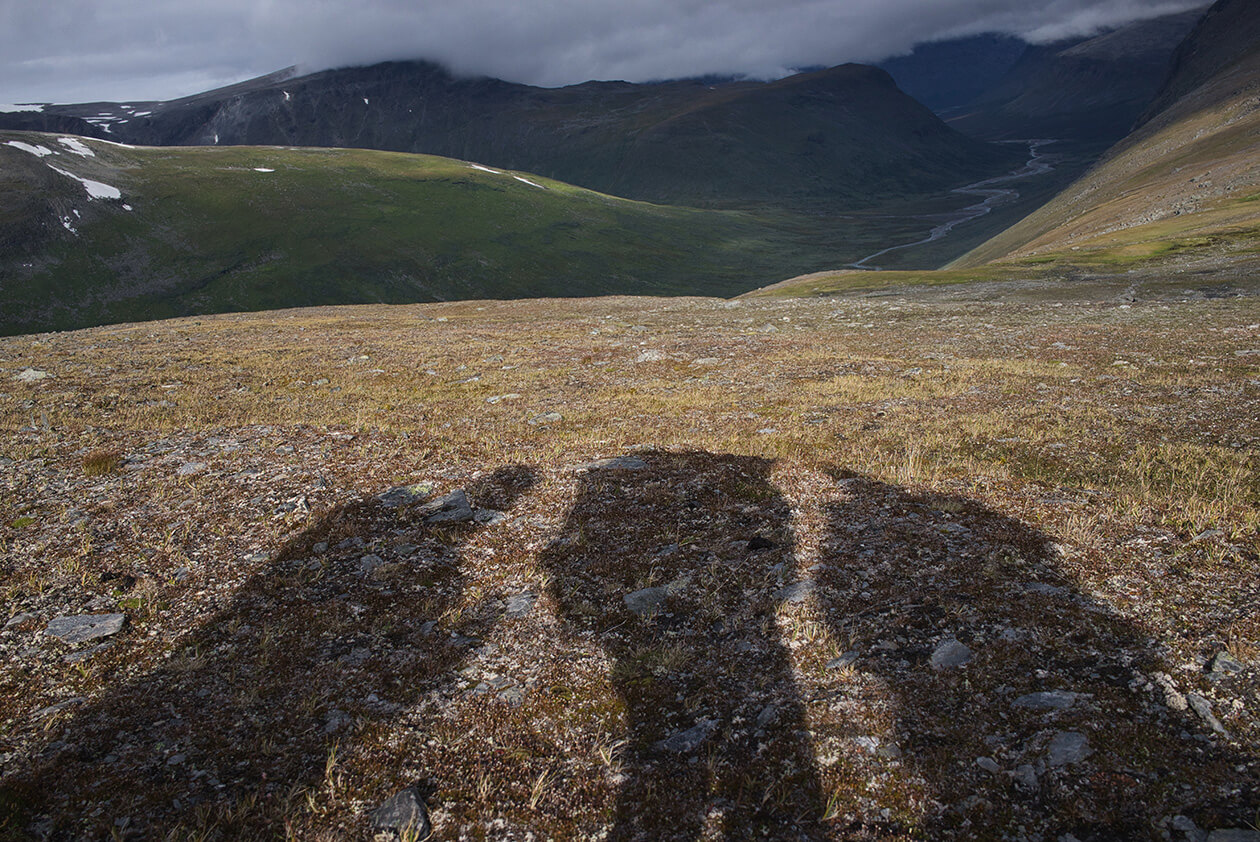
15.08.2019 - Day 13 (Sarvesvágge > Luohttoláhko - 14,1 km):
We awoke again to heavy rain and managed to get a weather forecast with the GPS device: It was supposed to clear up later that day around noon, as was often the case. We got everything ready so we could break camp as soon as the rain stopped. We chose an alternate route and instead of going up to Luohttoláko by means of the western valleys, we hiked up to the plateau straight from Sarvesvágge, which is the easiest route. As soon as we got close to the plateau, the clouds tore open to reveal the sun and an awesome play of shadow and light in the valley beneath. All of a sudden it felt like summer. Although it still was very windy.
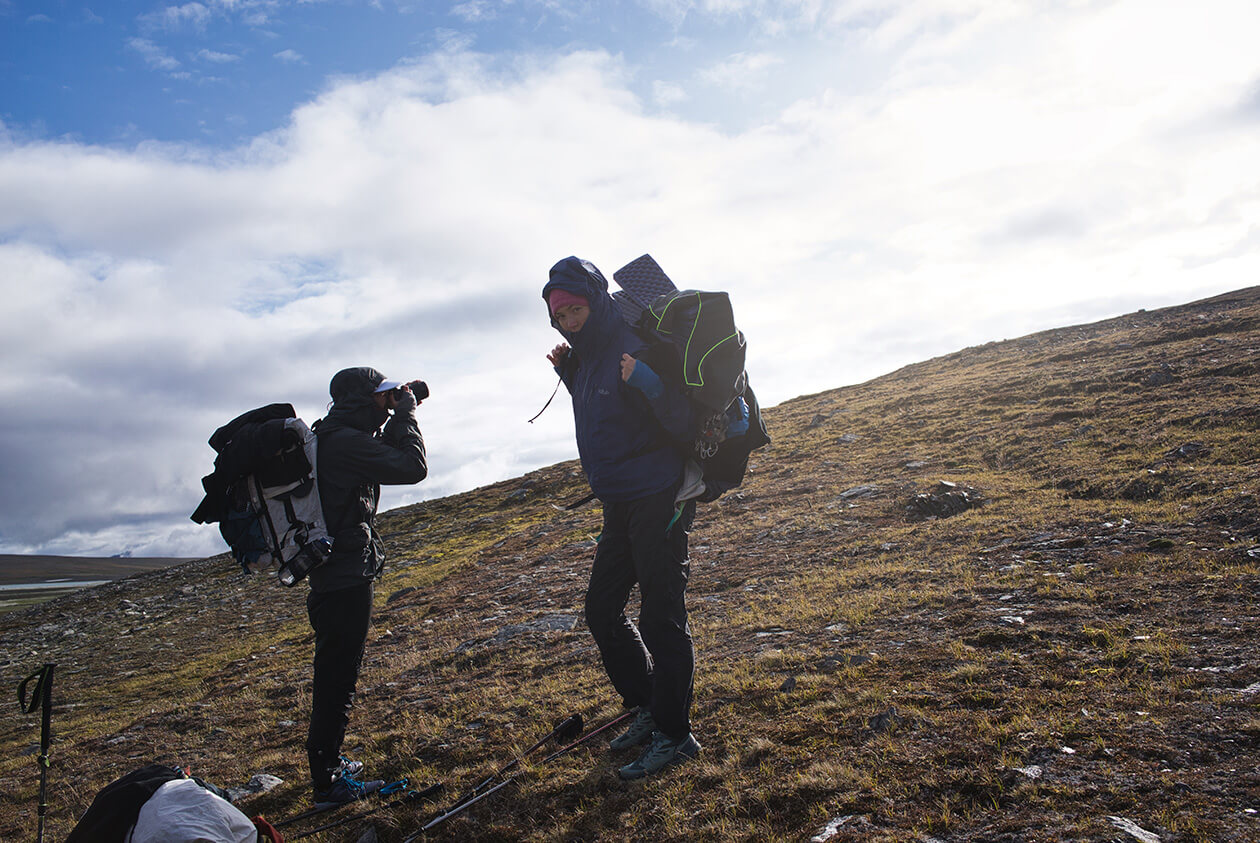




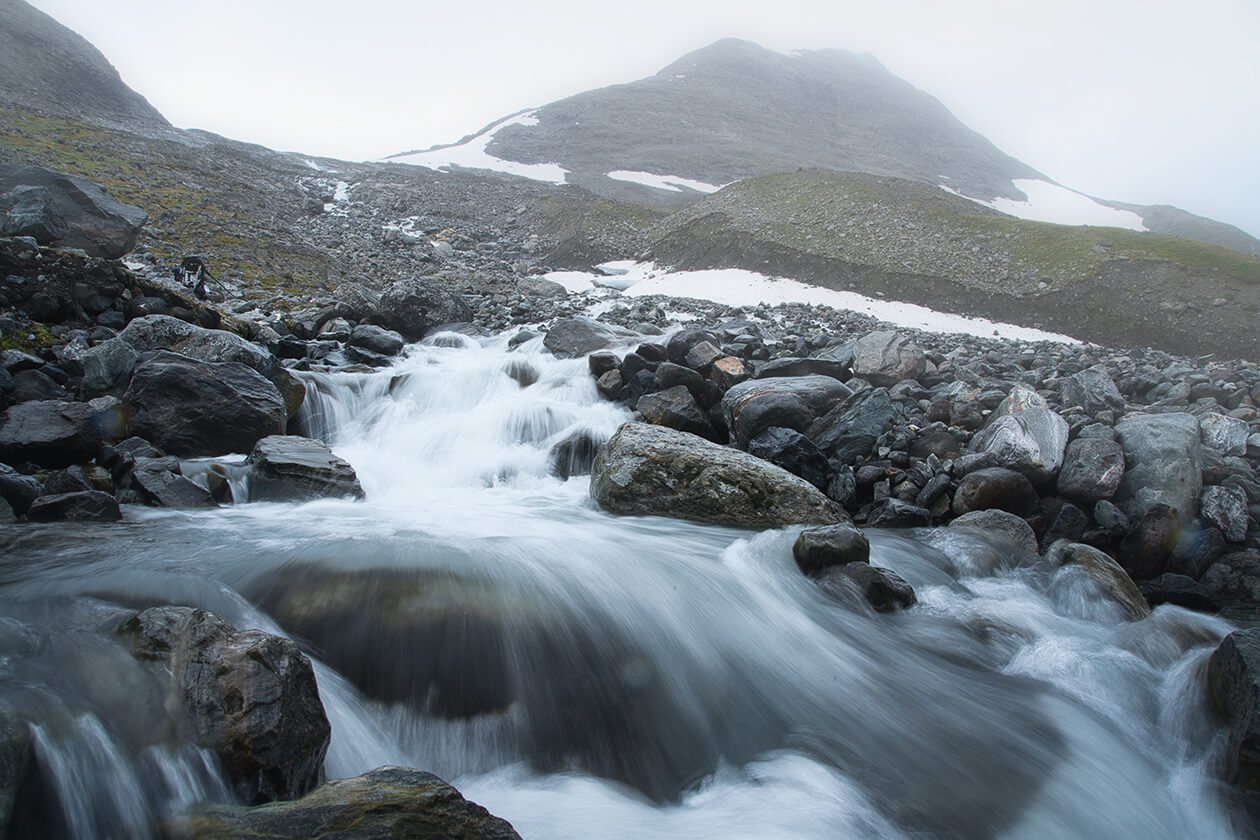


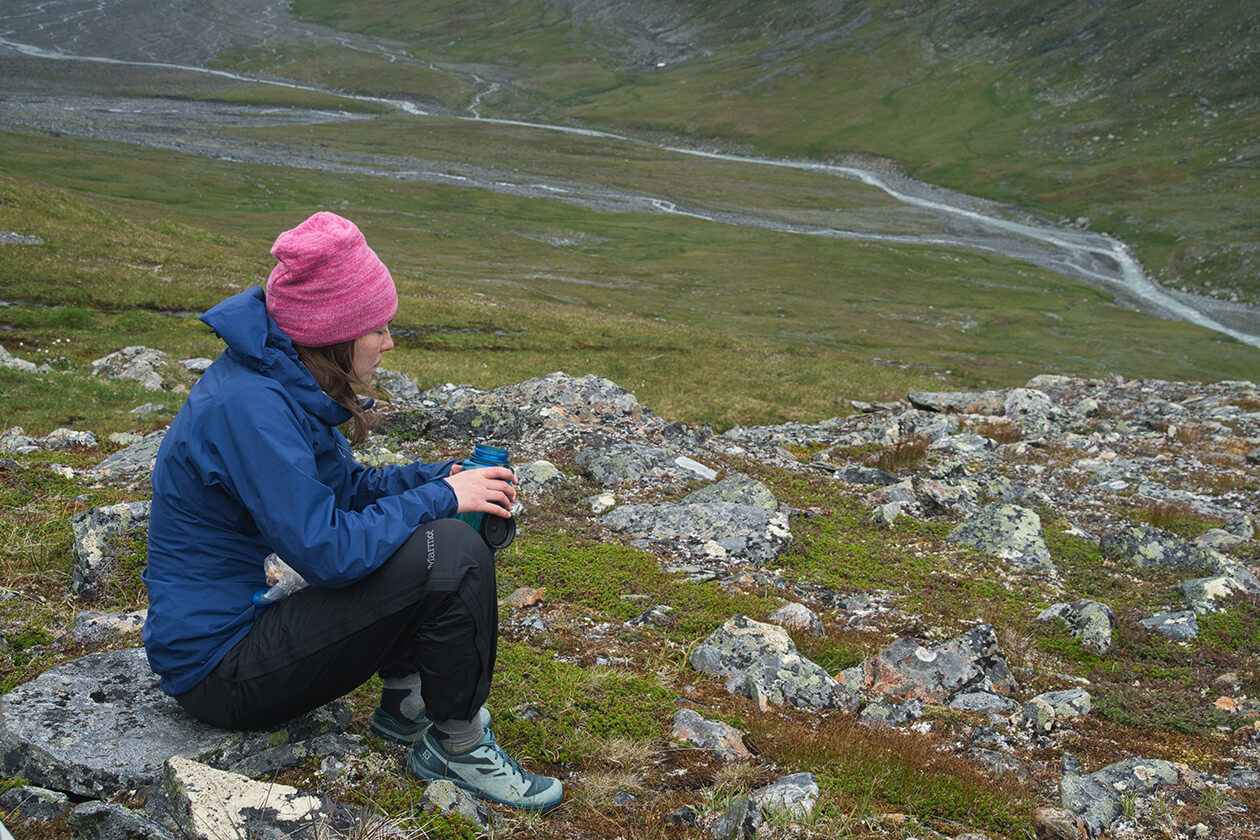
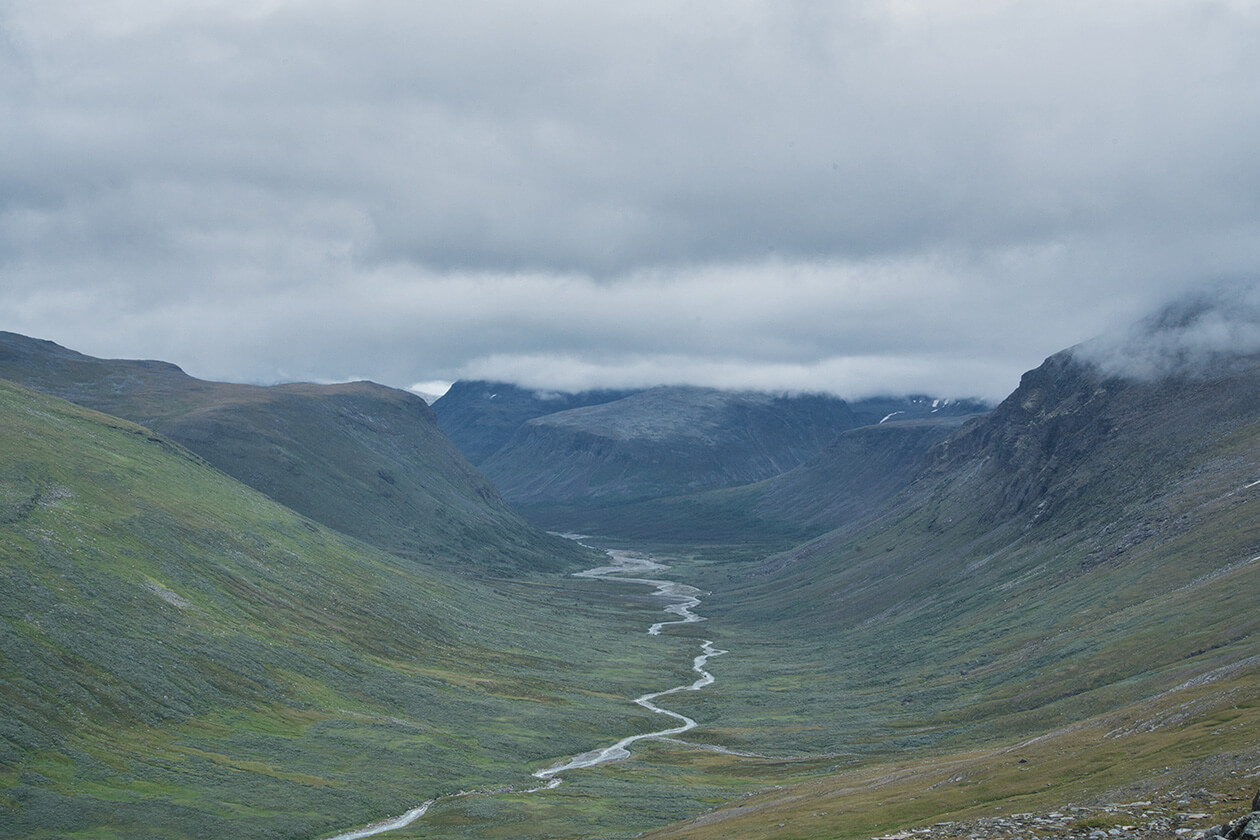

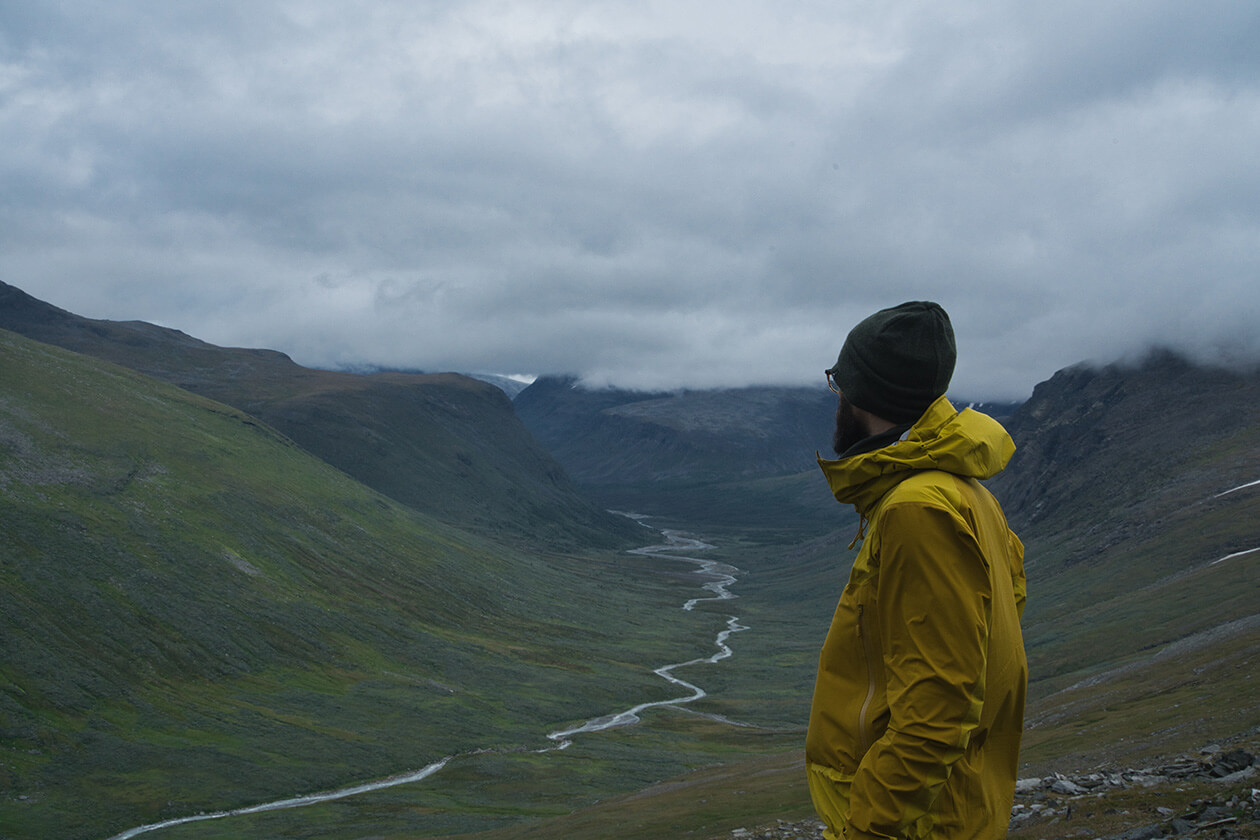
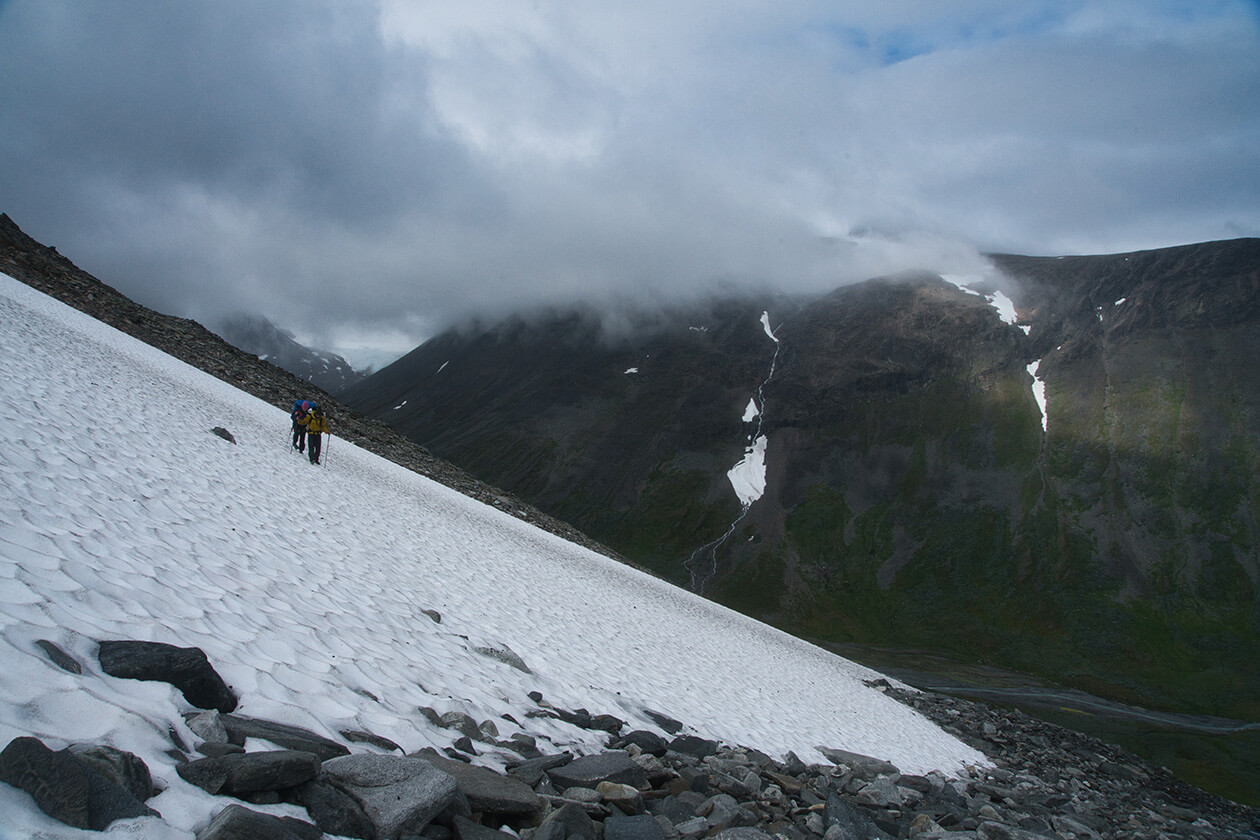
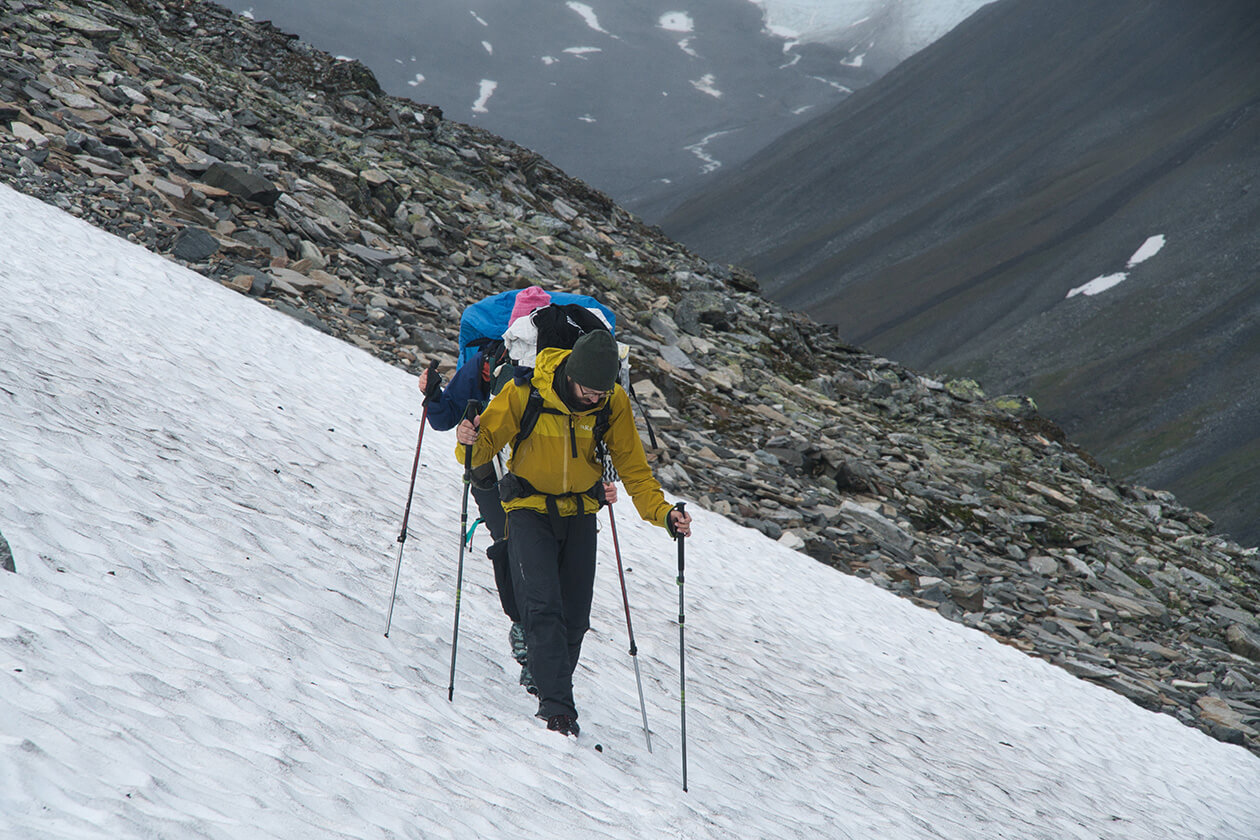
We hiked up Luohttoláko until we reached the last good campsite ahead of the glaciers. As soon as we had pitched our tent, the weather went awry again. We had just made it in time. Luohttoláko is a very exposed and open area where bad weather usually feels worse than it does in the valleys below. The weather report stated that it would be nice on the following day.

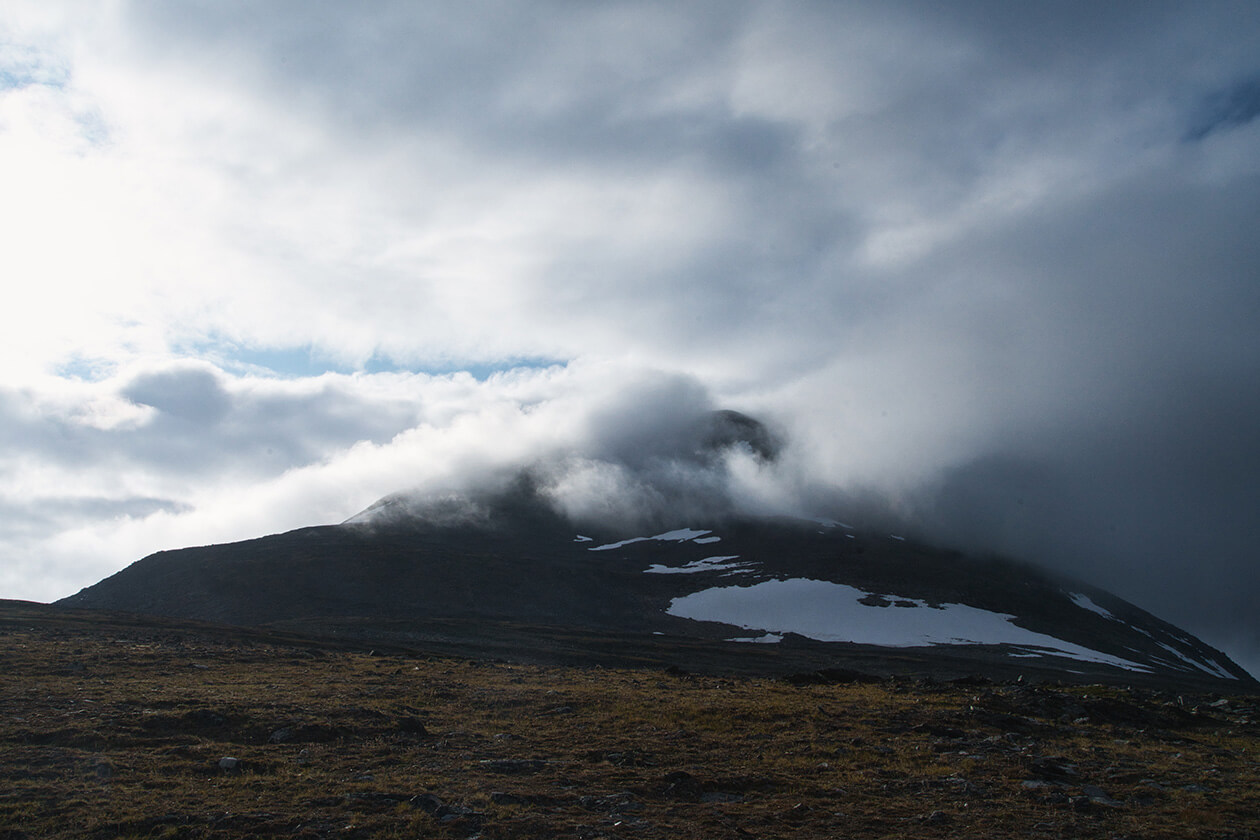
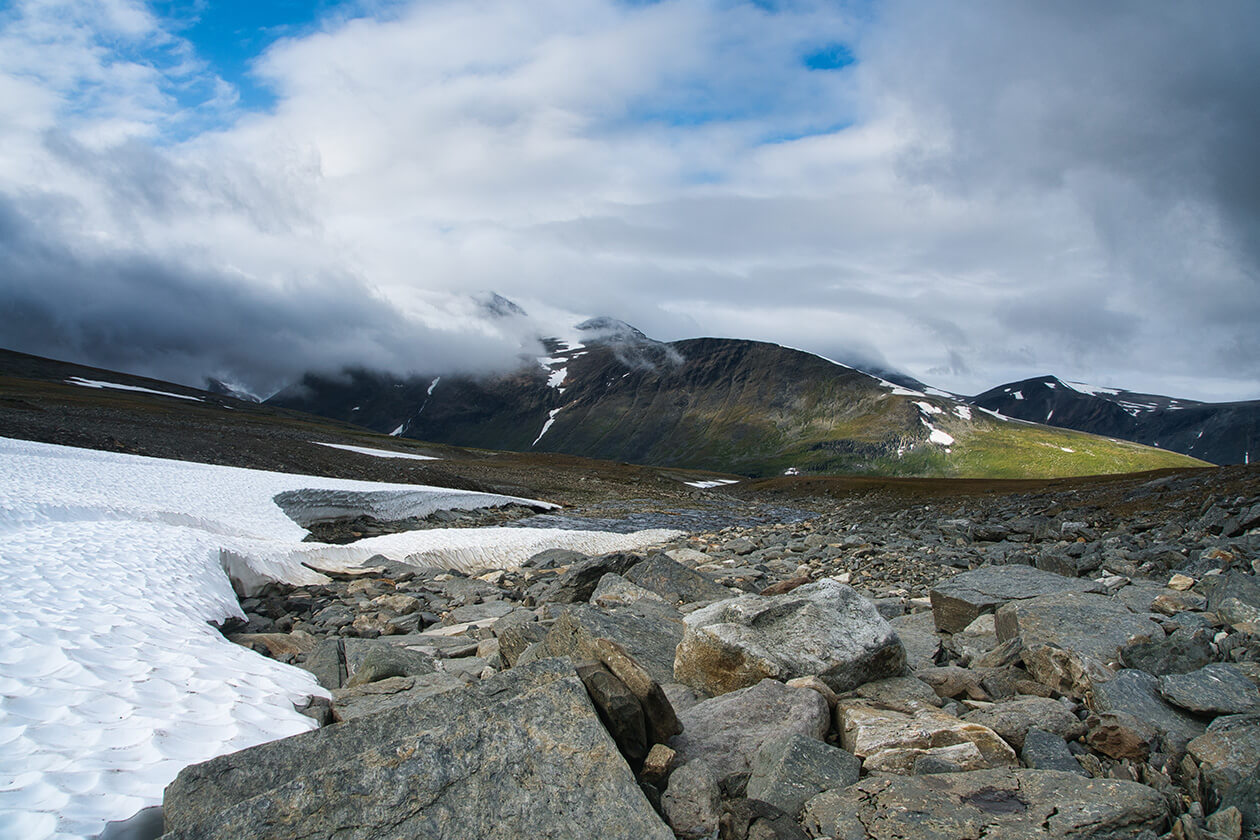
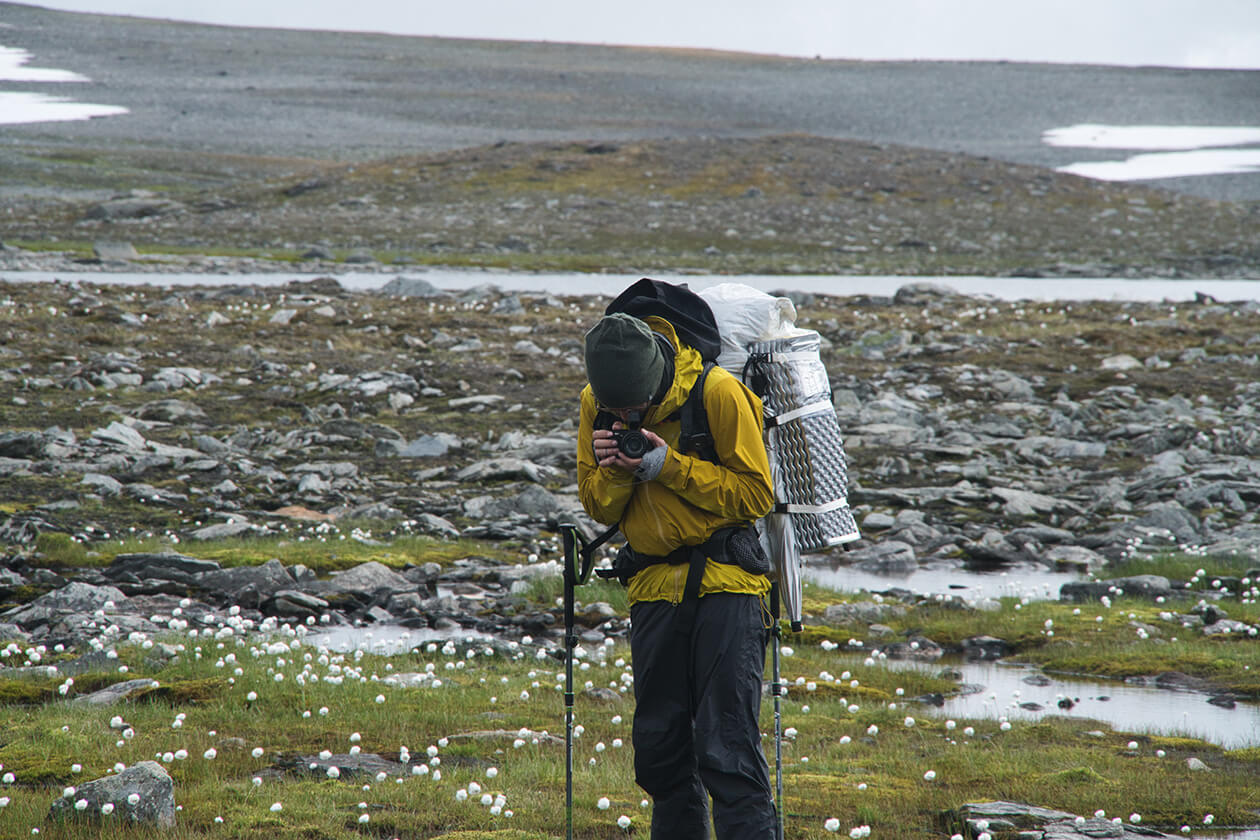
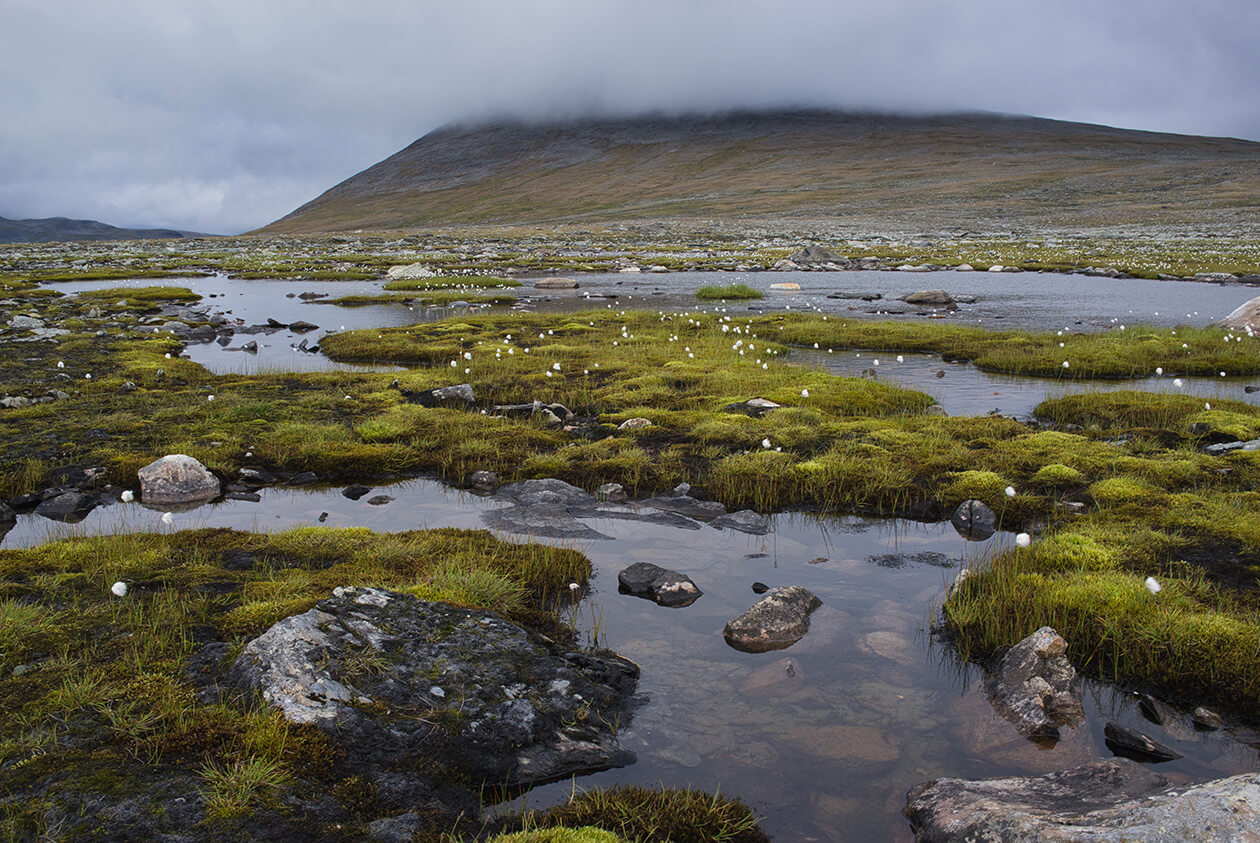

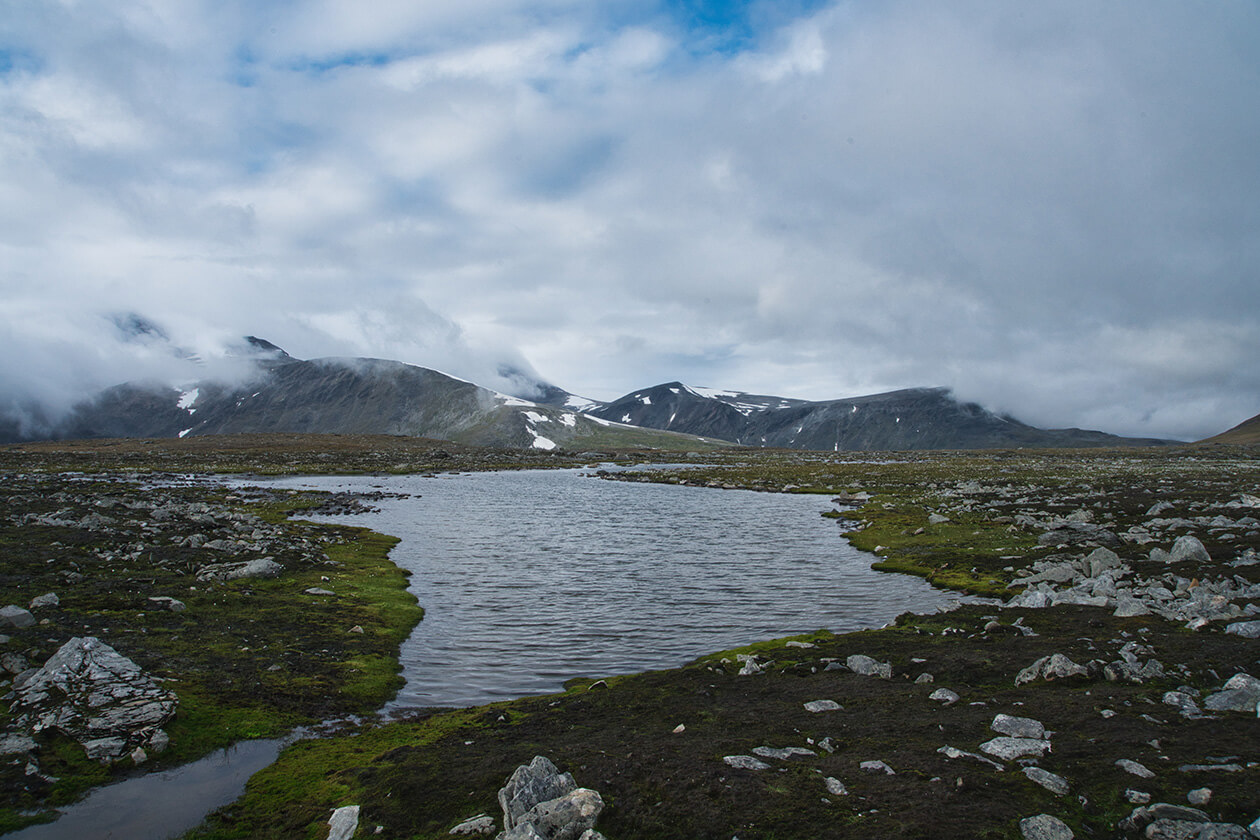
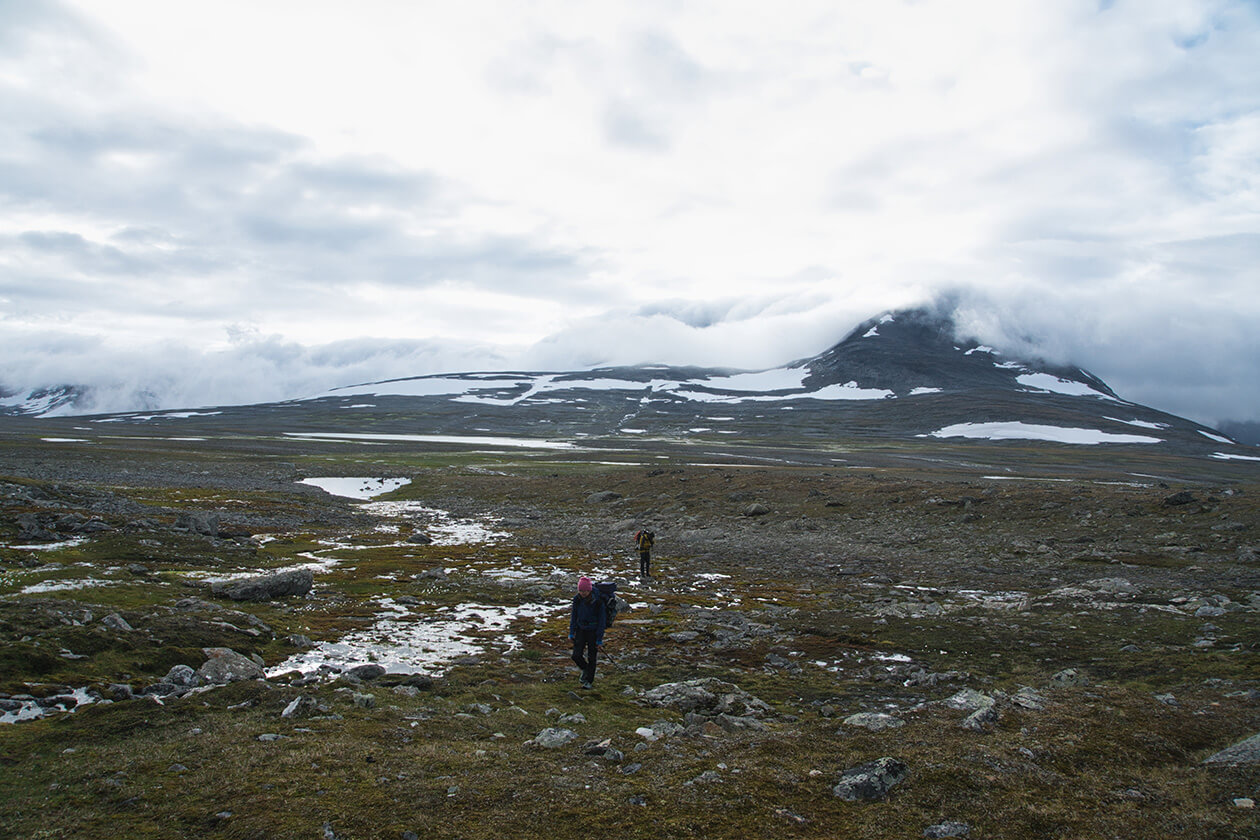
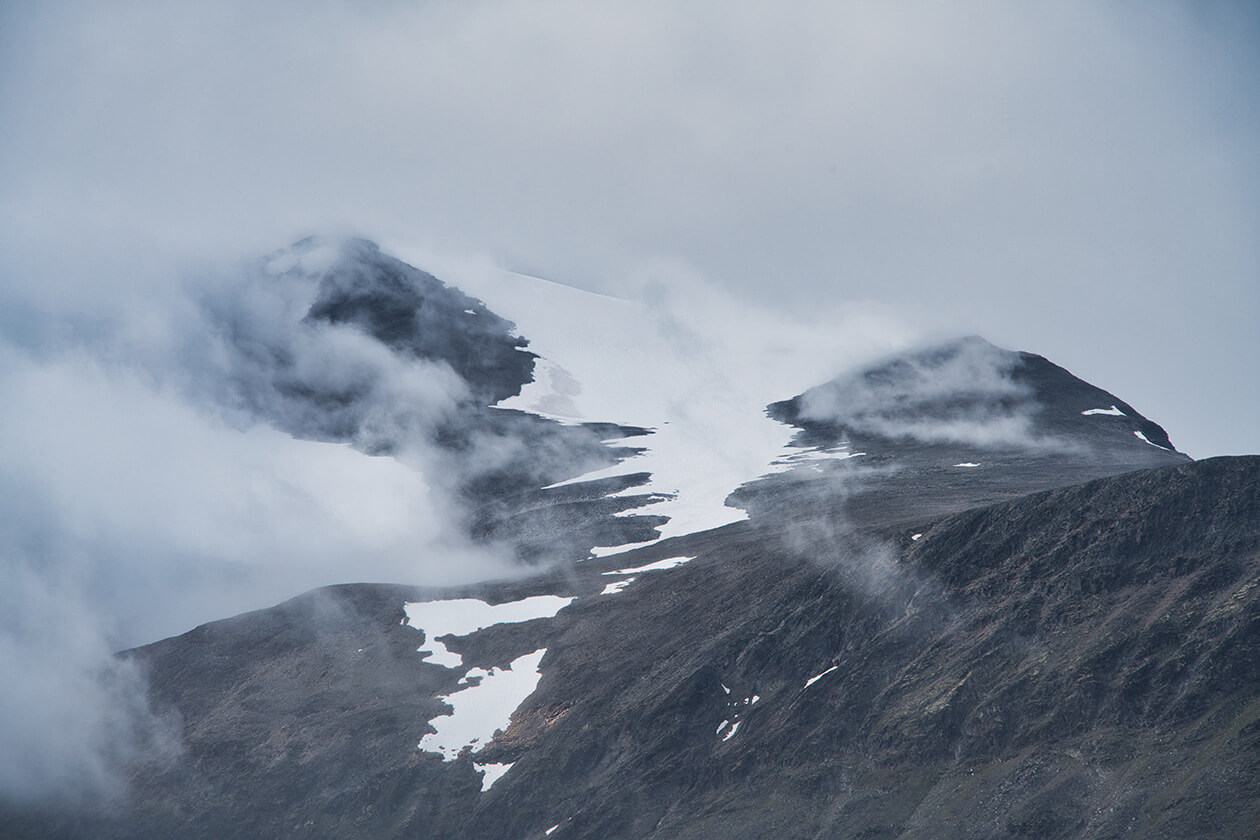
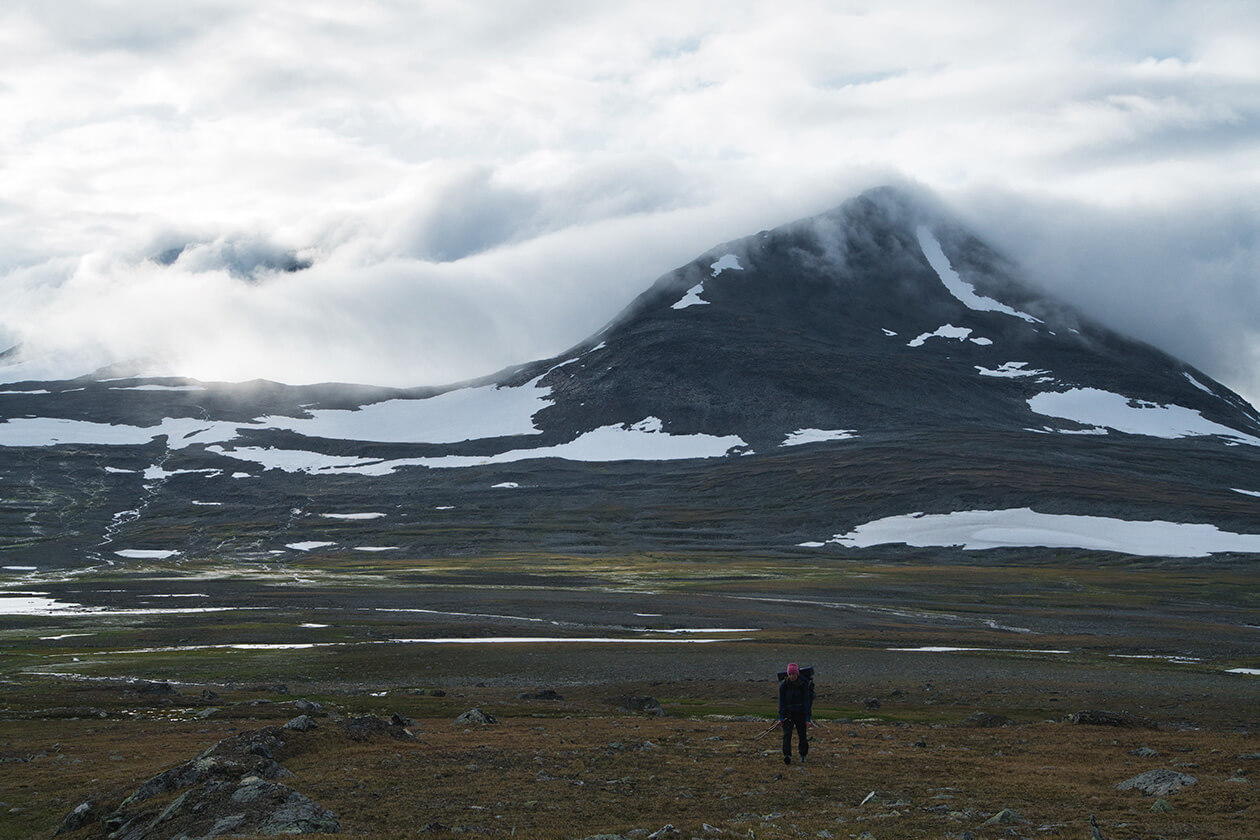
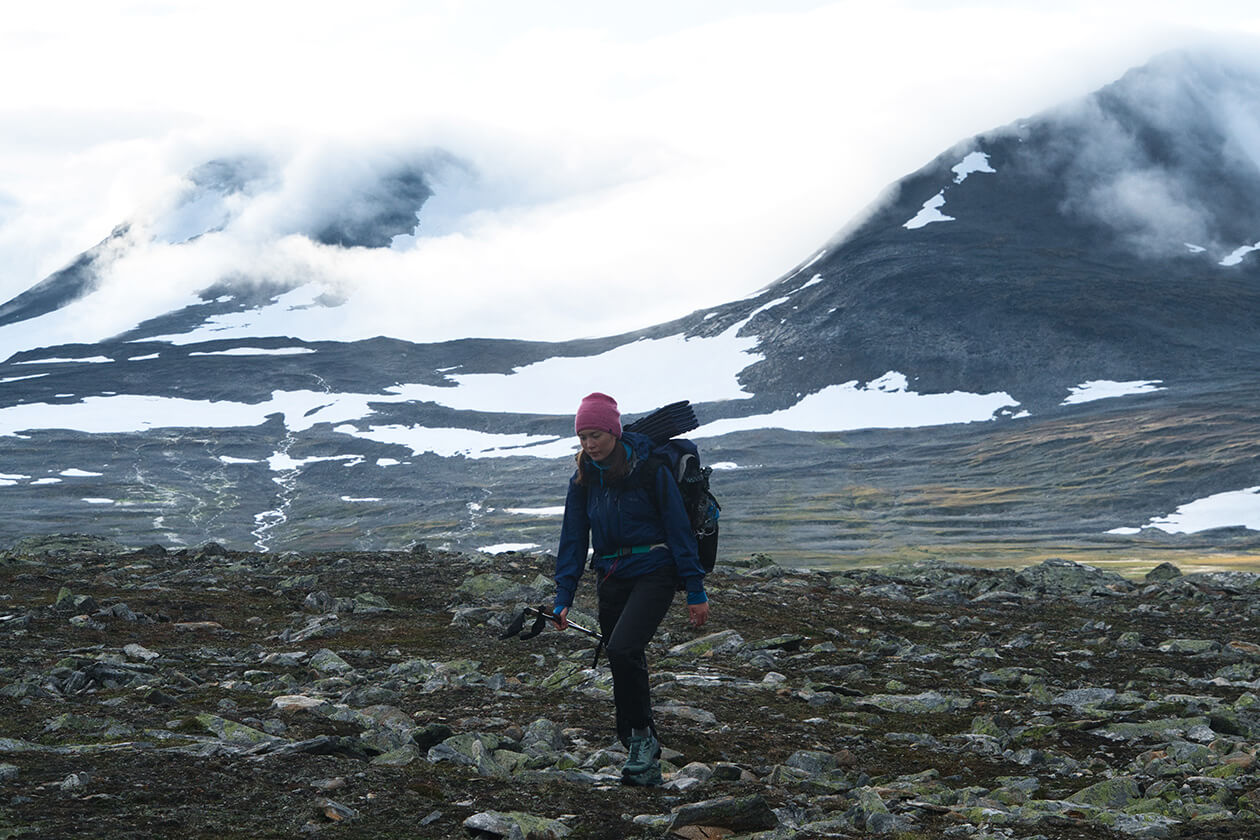

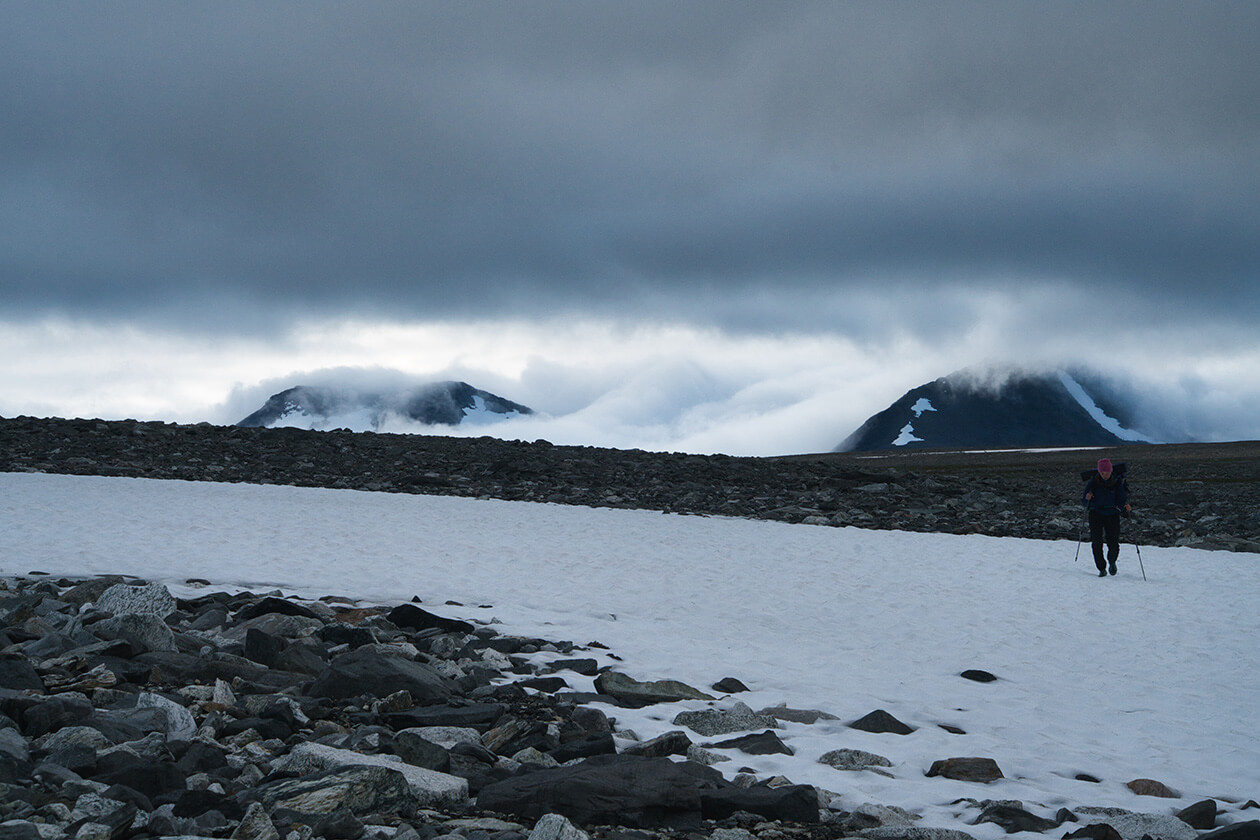

We had already decided that we would not take the western route, which I had planned as the main route down but instead hike over the pass and either walk the ridge or hike down the side of the Bårddejiegna glacier. Since the weather reports haven’t been too accurate and this hike has been by far confronted with the worst weather I have ever experienced in Sarek, we wanted to cut it short as it might happen that we would need to take some more zero days to take shelter and dry our wet shells. We went to bed after dinner and heard the rain pounding on and off during the night.

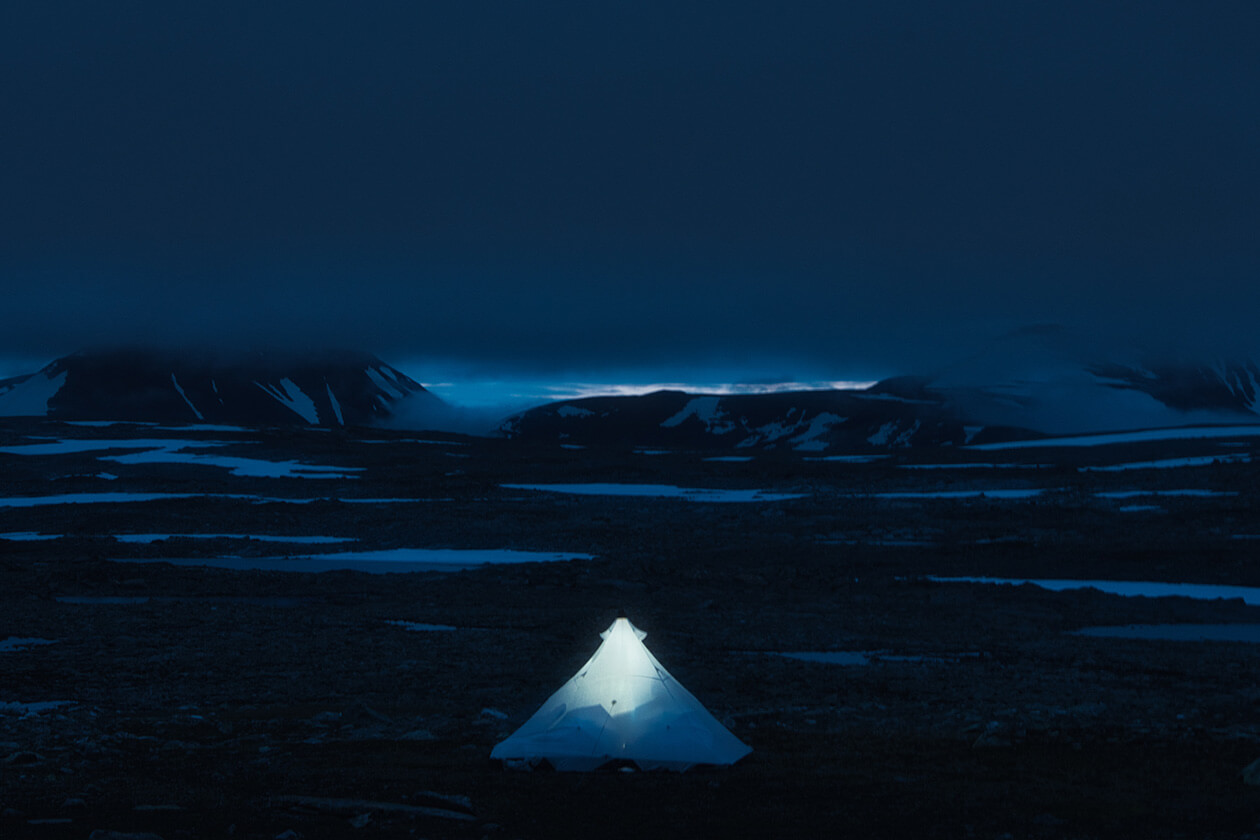

16.08.2019 - Day 14 (Luohttoláko > Bårddejiegna > Valley with no name - 15,1 km)
The next day we awoke to brilliant sunlight. It was warm enough that I could rinse off and let the wind blow me dry. My merino T-shirt, which I had also washed, was dry within 30 minutes. Until noon, we made use of the sunny morning to charge our battery packs which were in dire need of power. During that morning I took a stroll around the base of the glaciers of the Pårte massive and took some pictures.
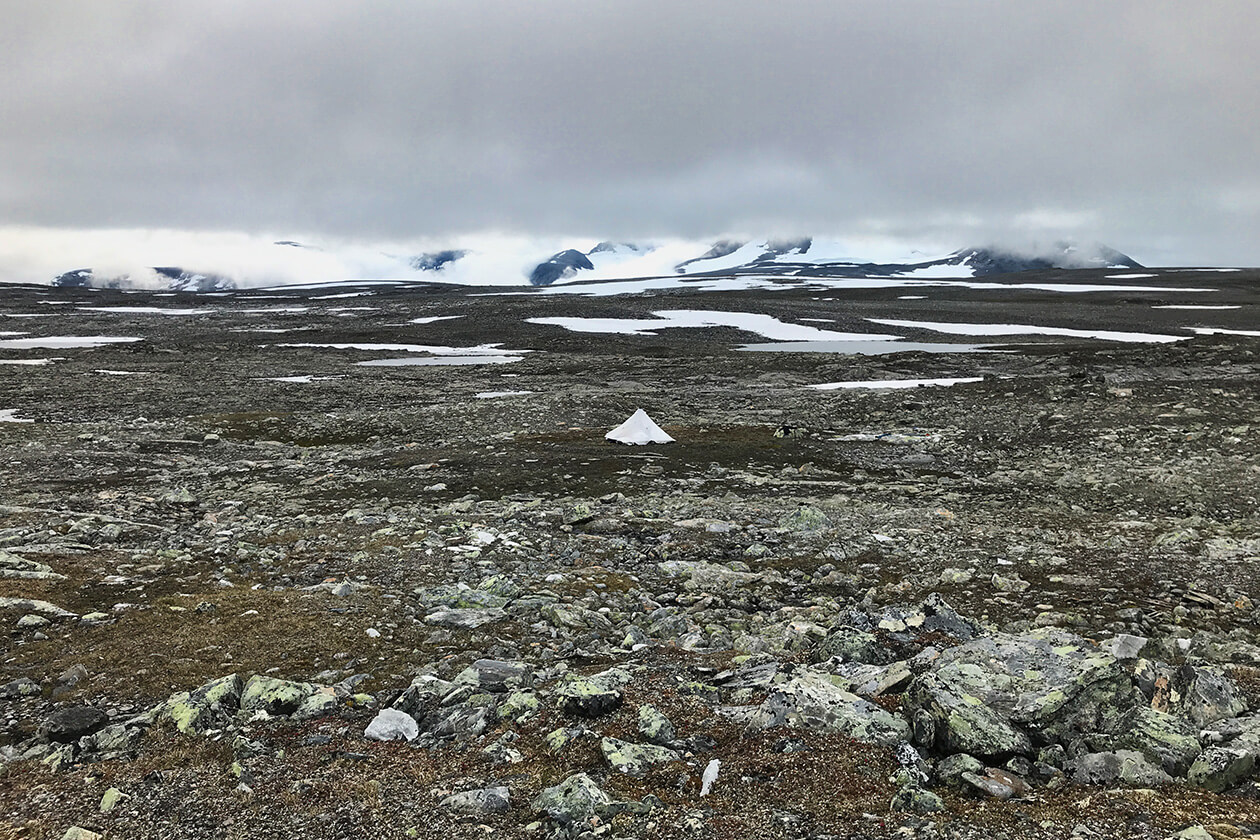
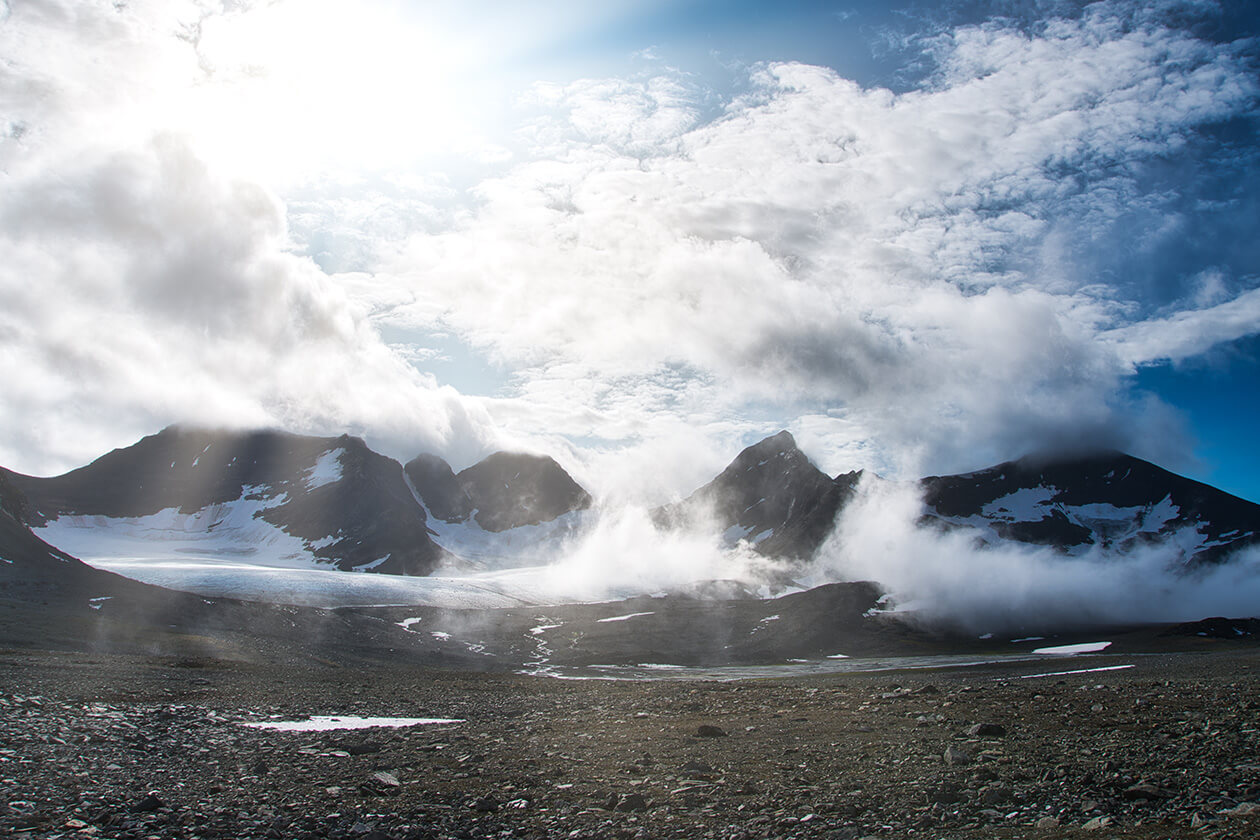
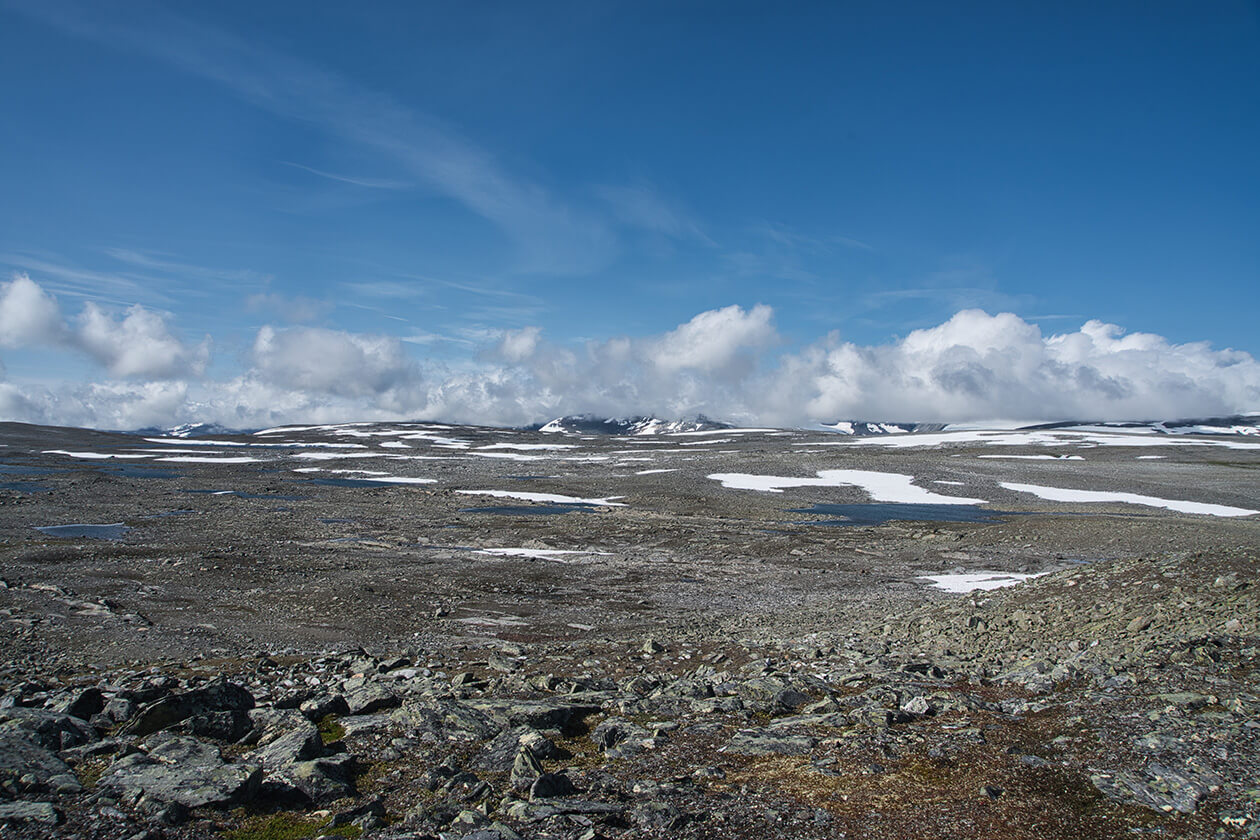
After we had packed everything up, we headed up to the pass. At the base of the Lullihatjåhkkå glacier we found a beautiful half-frozen lake named Lullihajávrre and took some pictures in front of it. Then we started the climb. As soon as we were half-way up the weather turned on us. We broke out our shell layers and warm clothes and climbed further up. All of a sudden we were confronted by hail and snow. As we reached the top of the pass, we stood in awe of the scene that unfolded before us. That glacier was huge. Up on the pass we were greeted by an icy wind blowing up from the glacier.


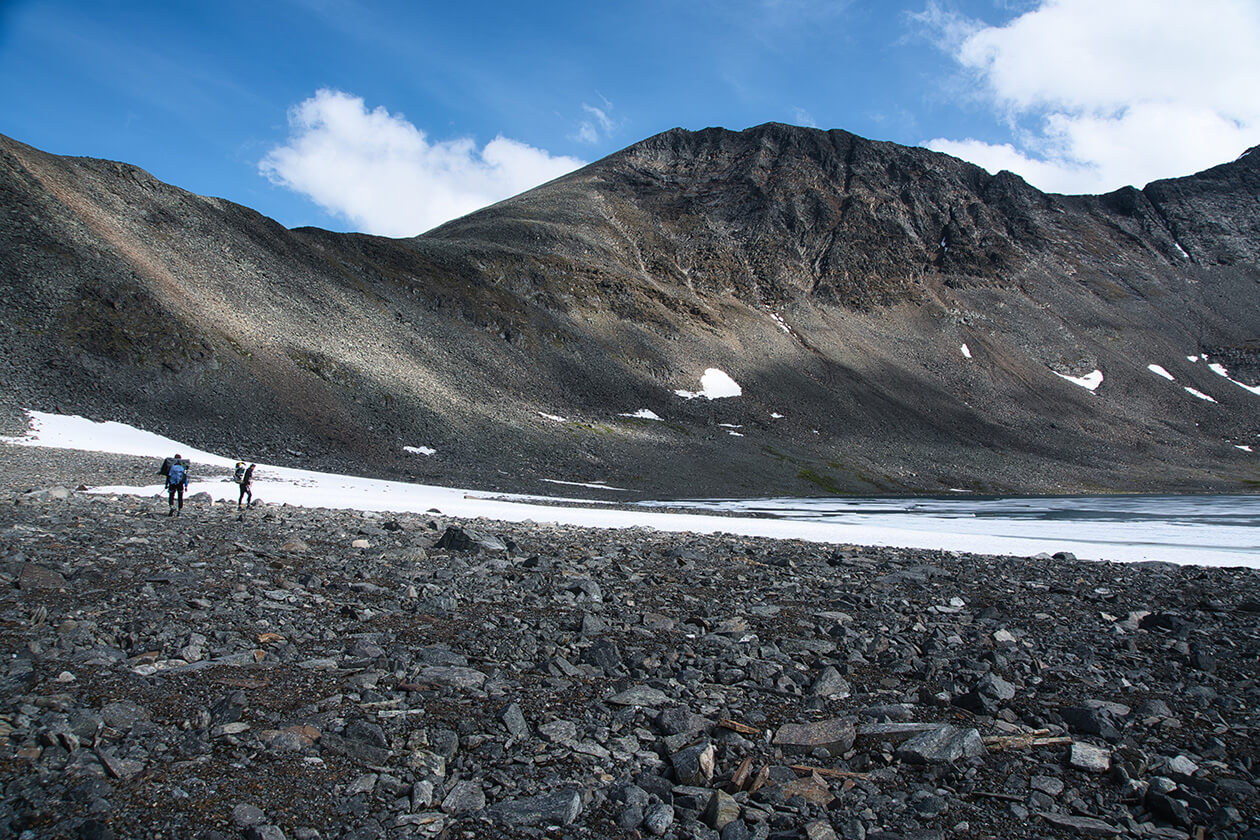
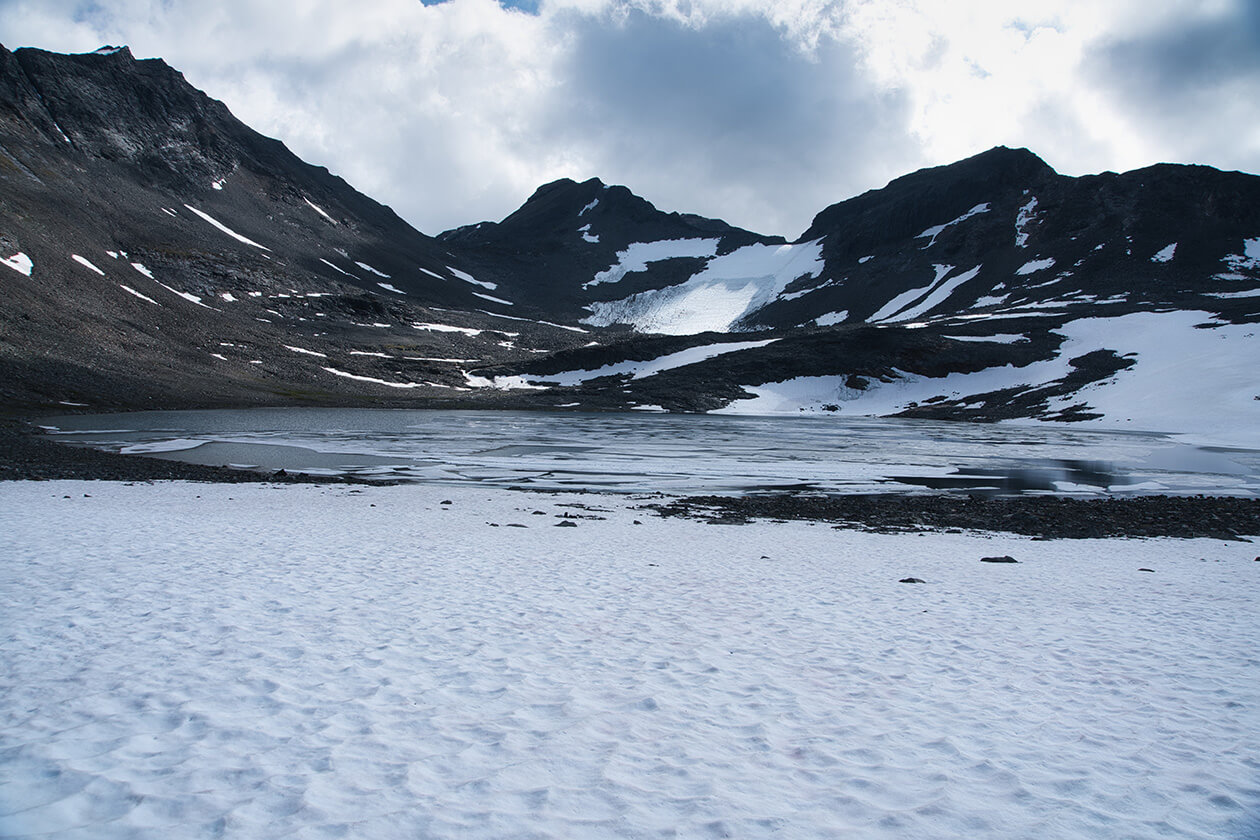
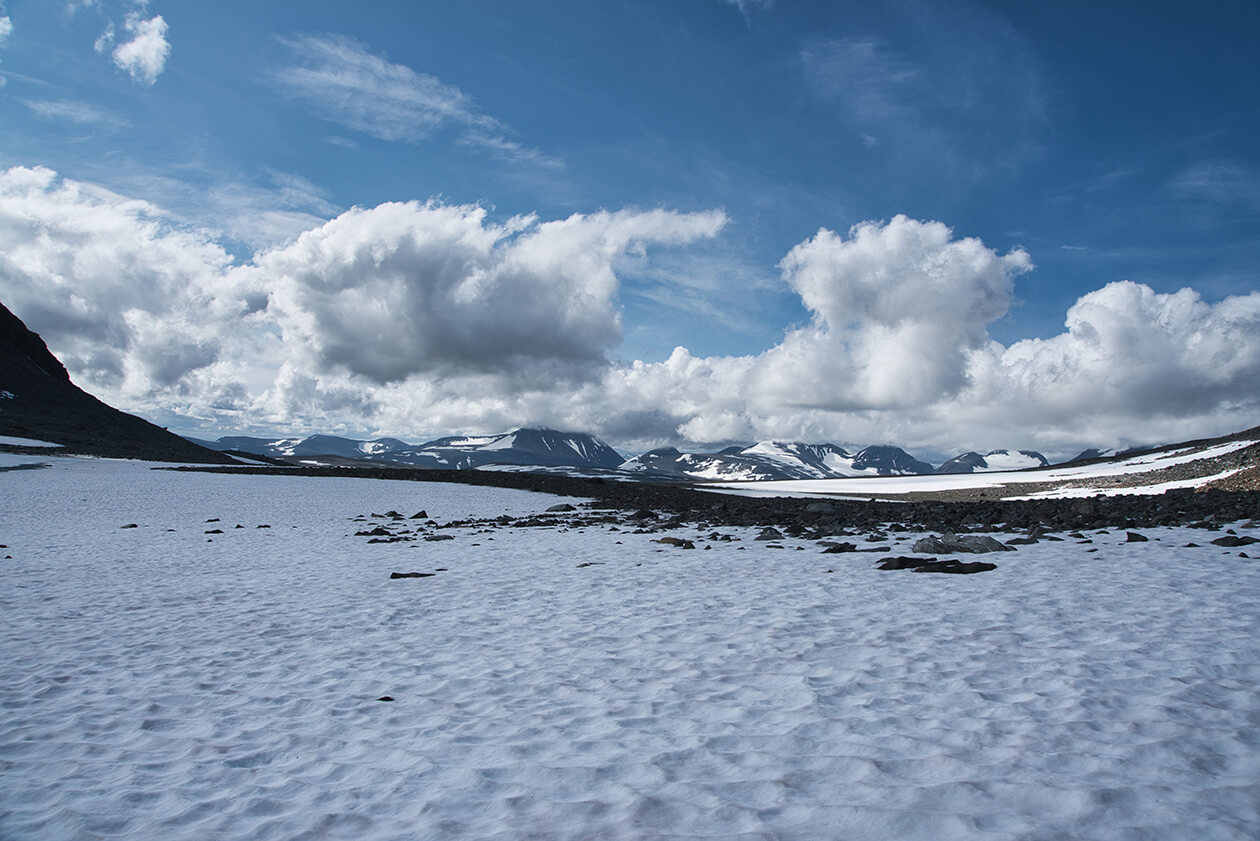
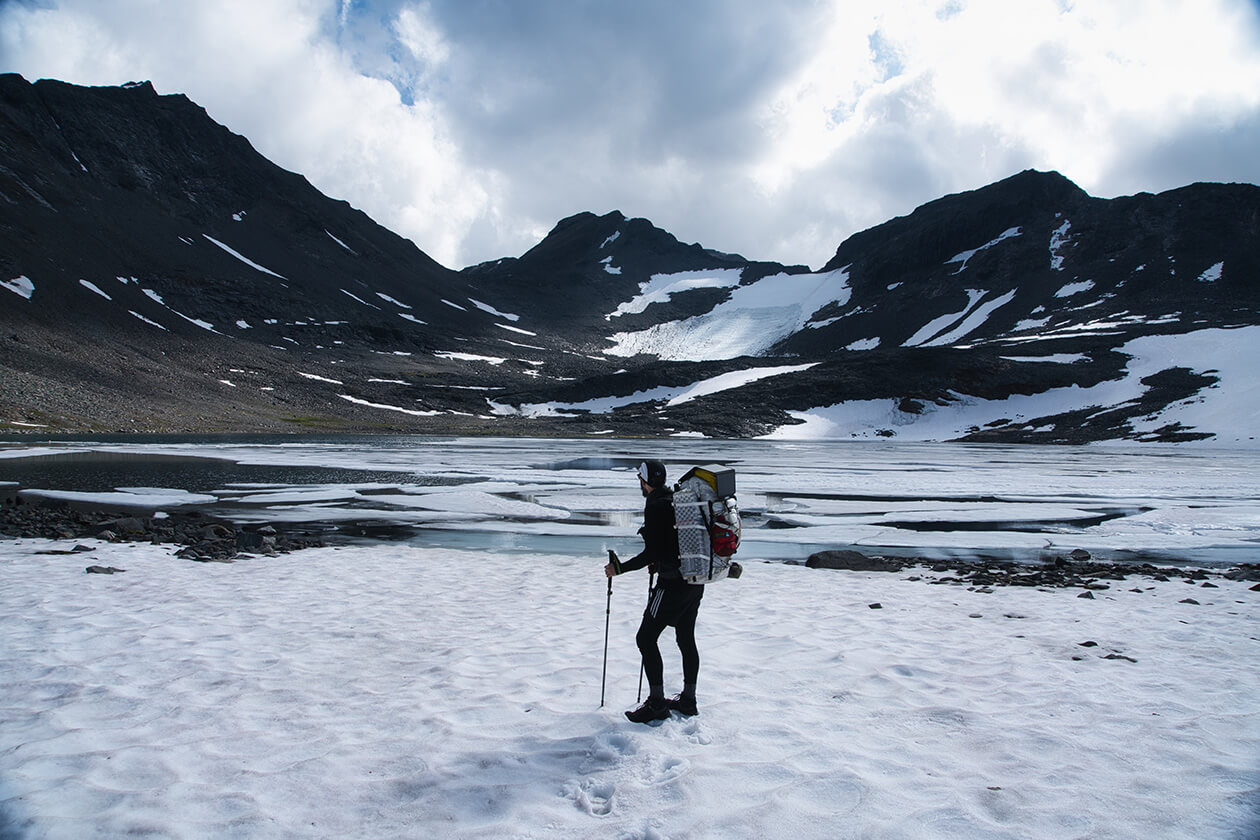
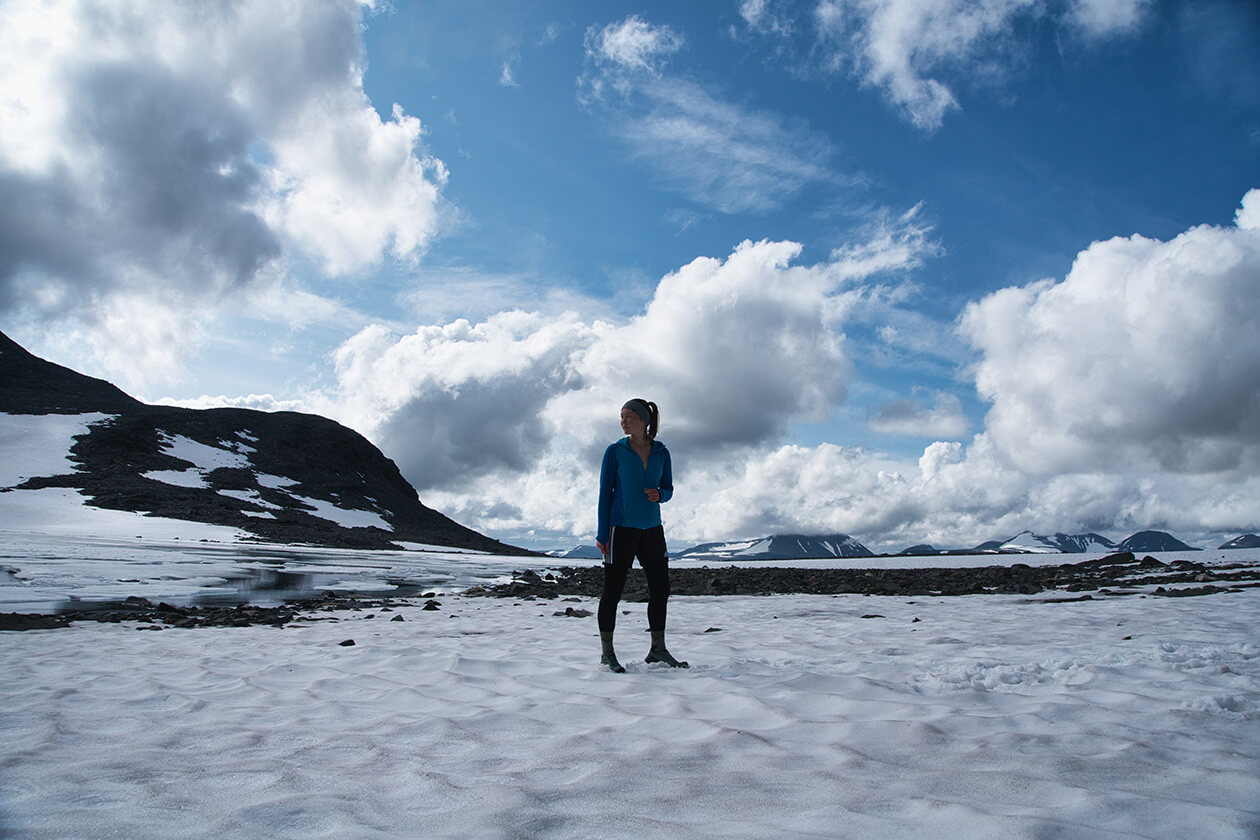
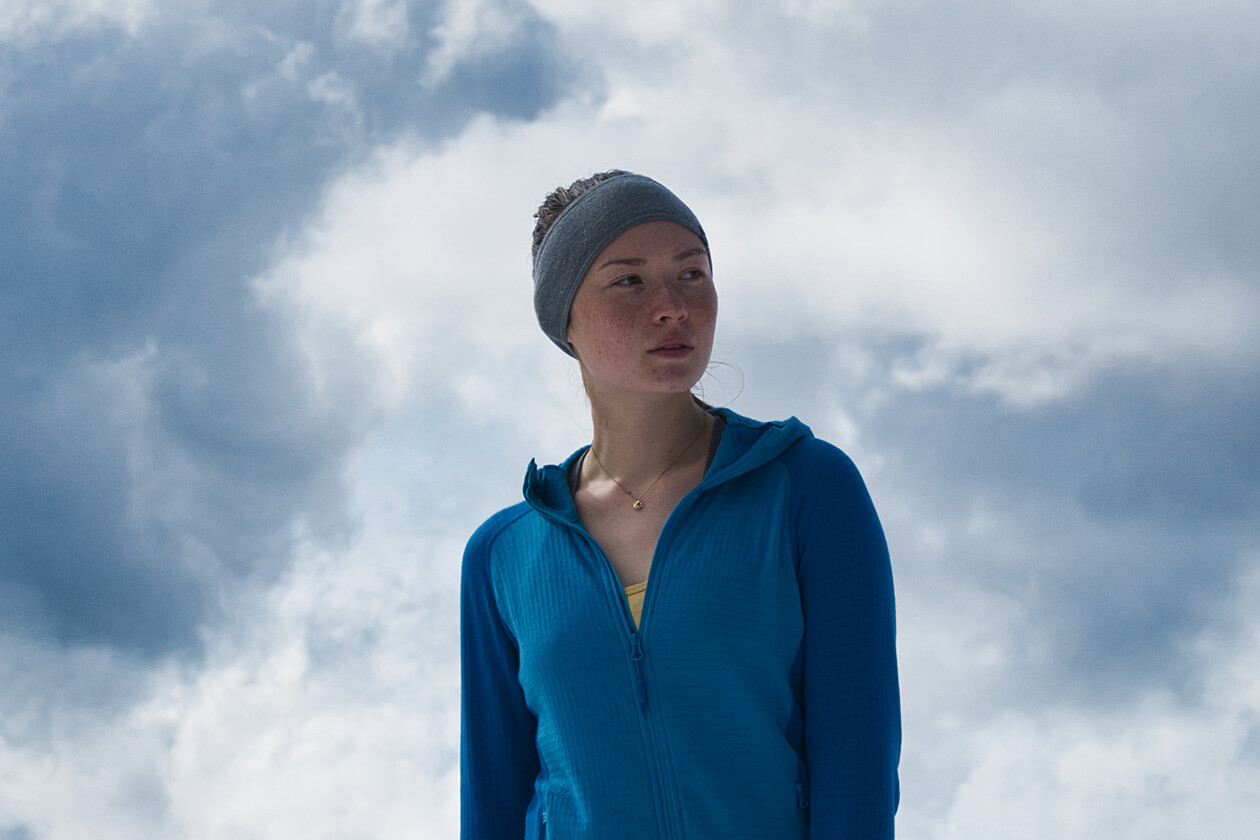
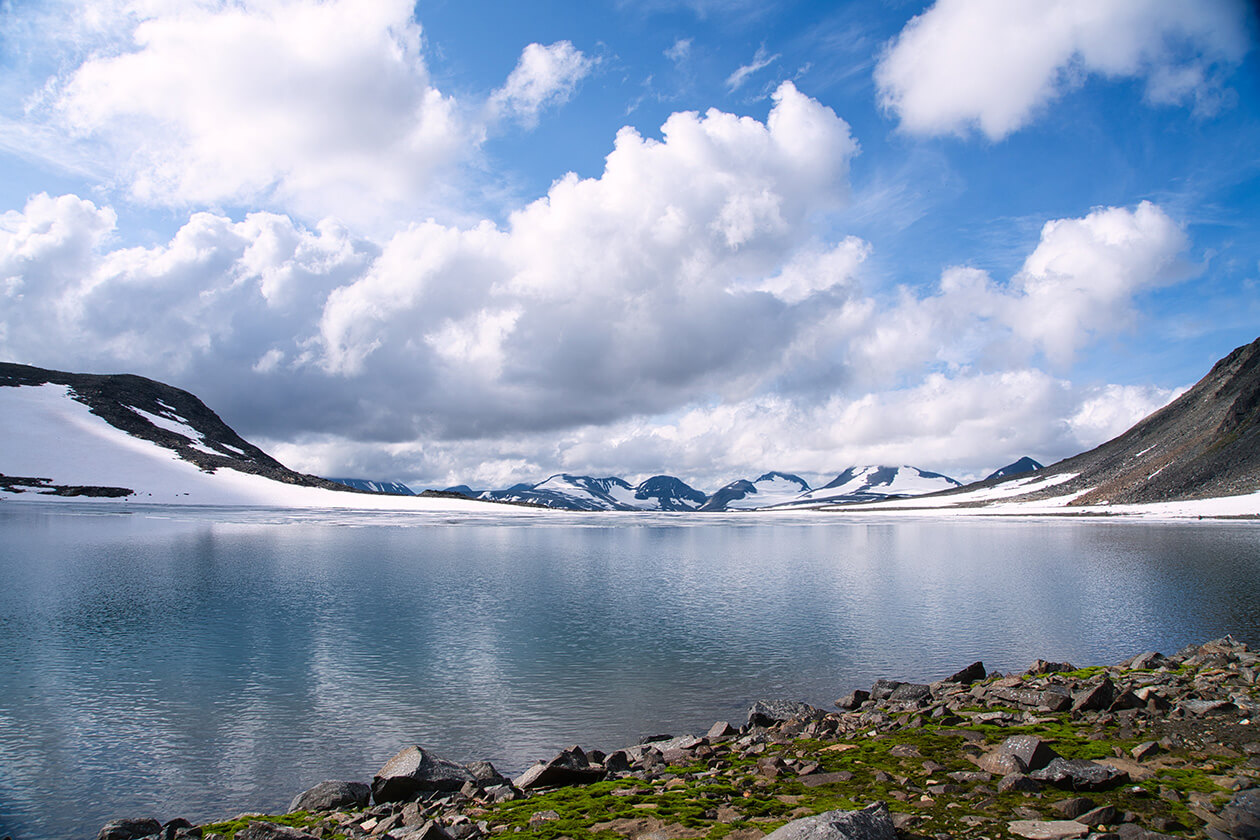

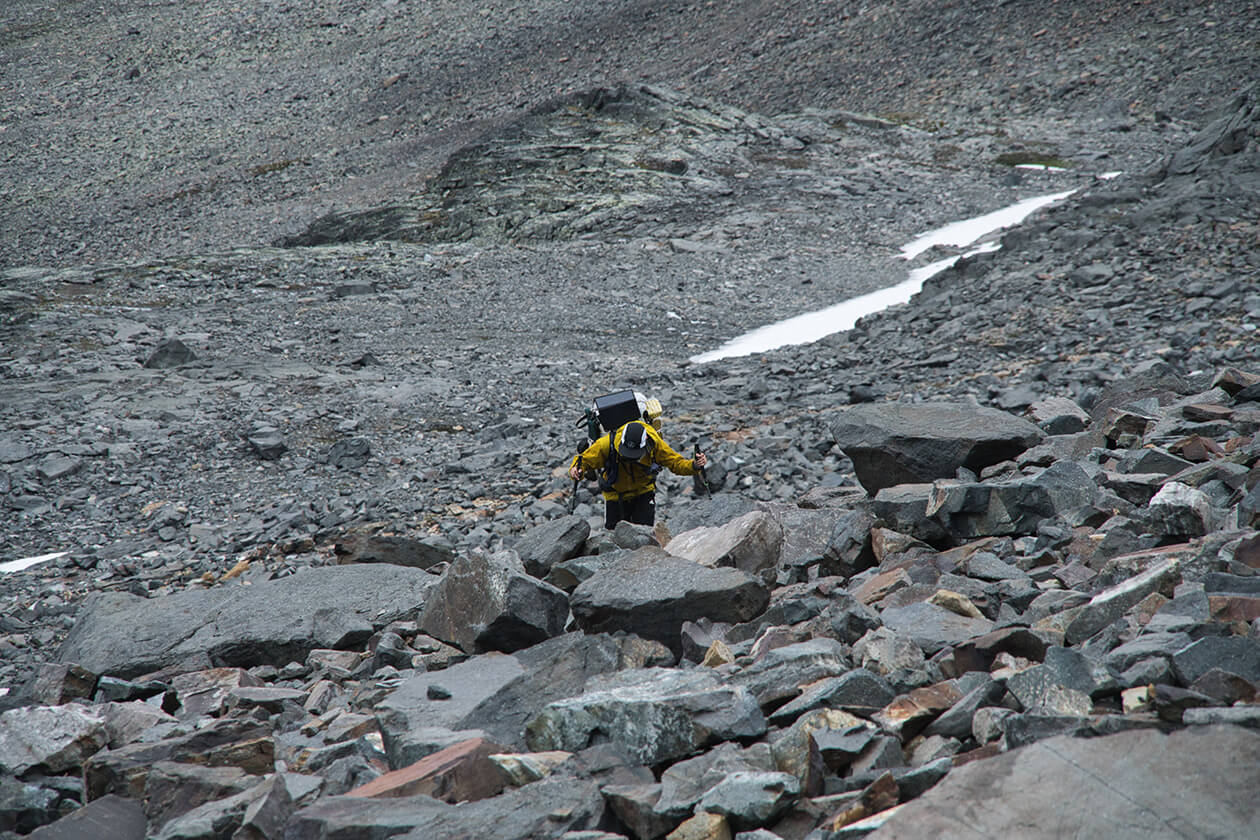

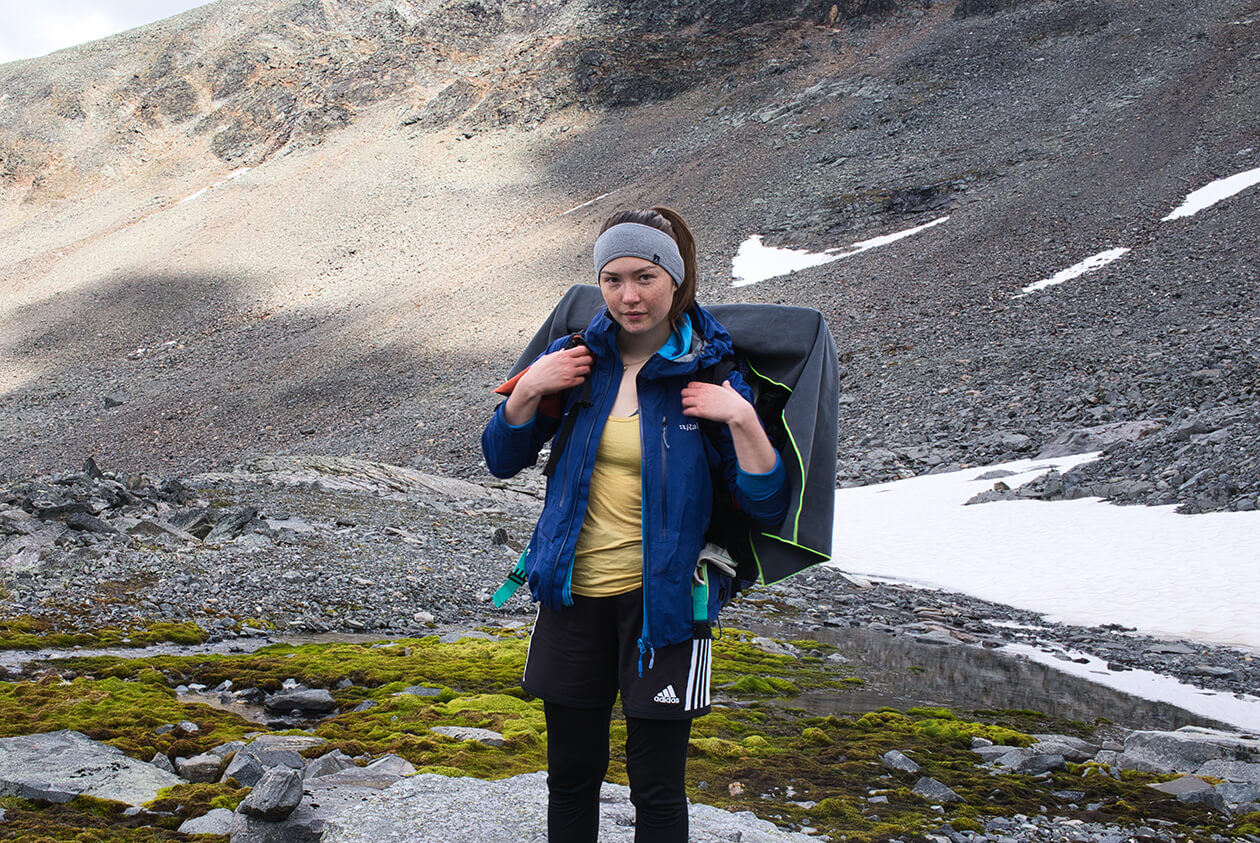
Hendrik stayed with our packs while Mine and I traversed the snowfield above the glacier to get a glimpse of the ridge to see if it was doable without the aid of specialized mountaineering gear. We climbed all the way to the top over slippery loose rocks while the snow, rain and hail was getting denser by the minute. Once we were up at the top of Tvyllingryggen, we saw that there was no way we were going to do this without harness and rope. Especially not in this kind of weather.

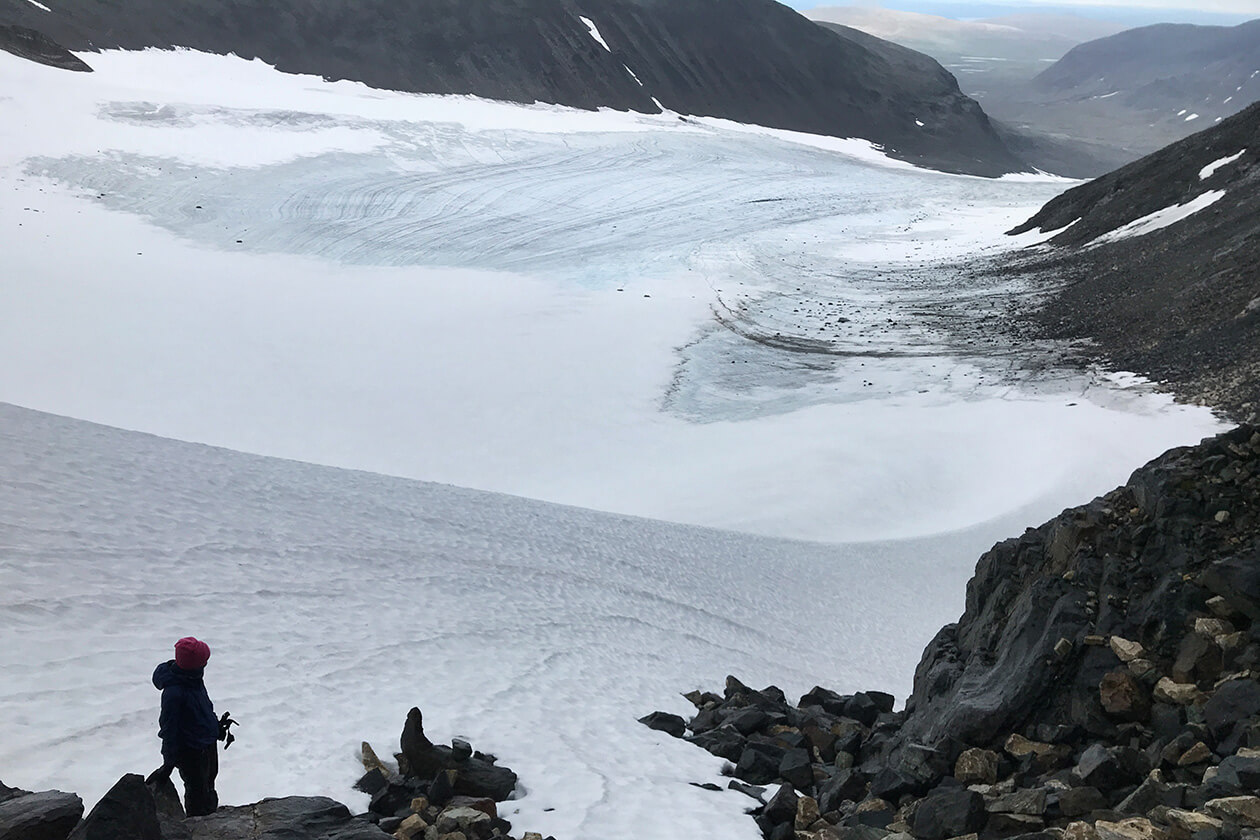

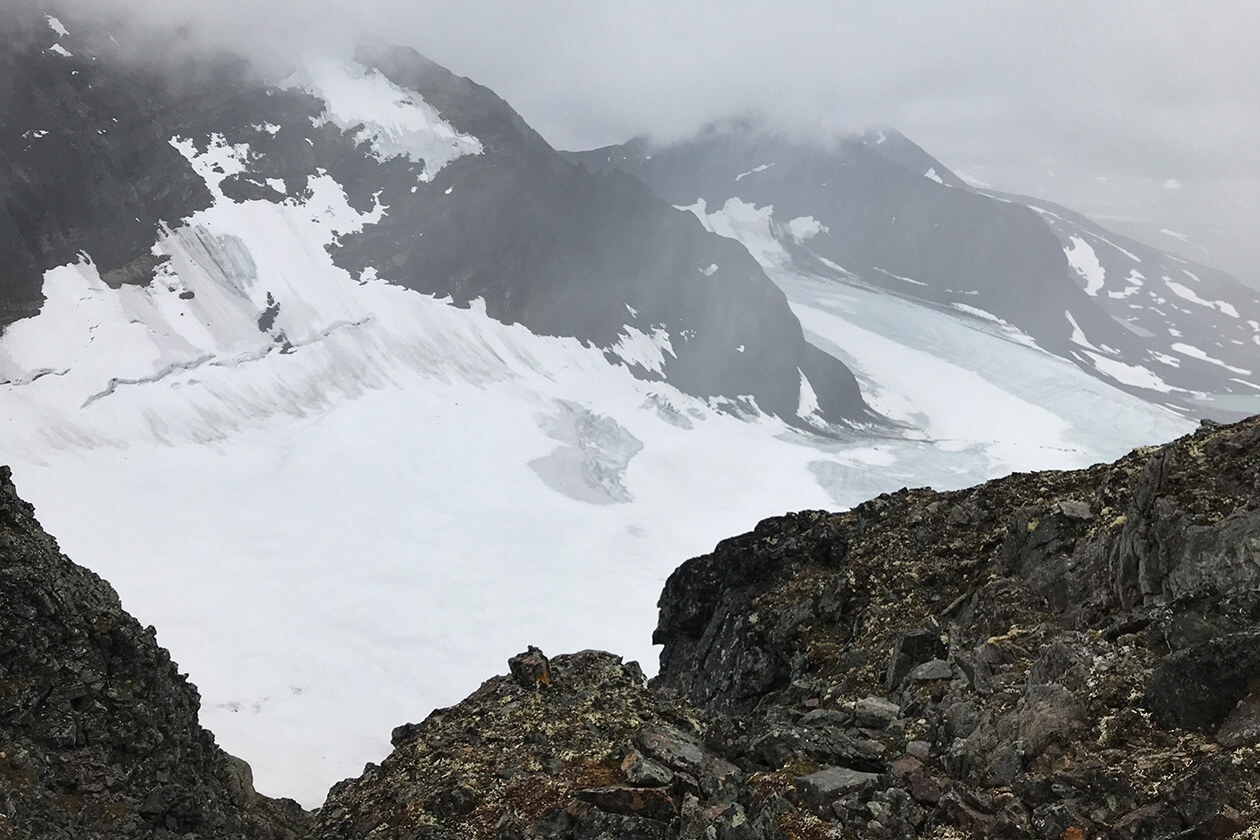
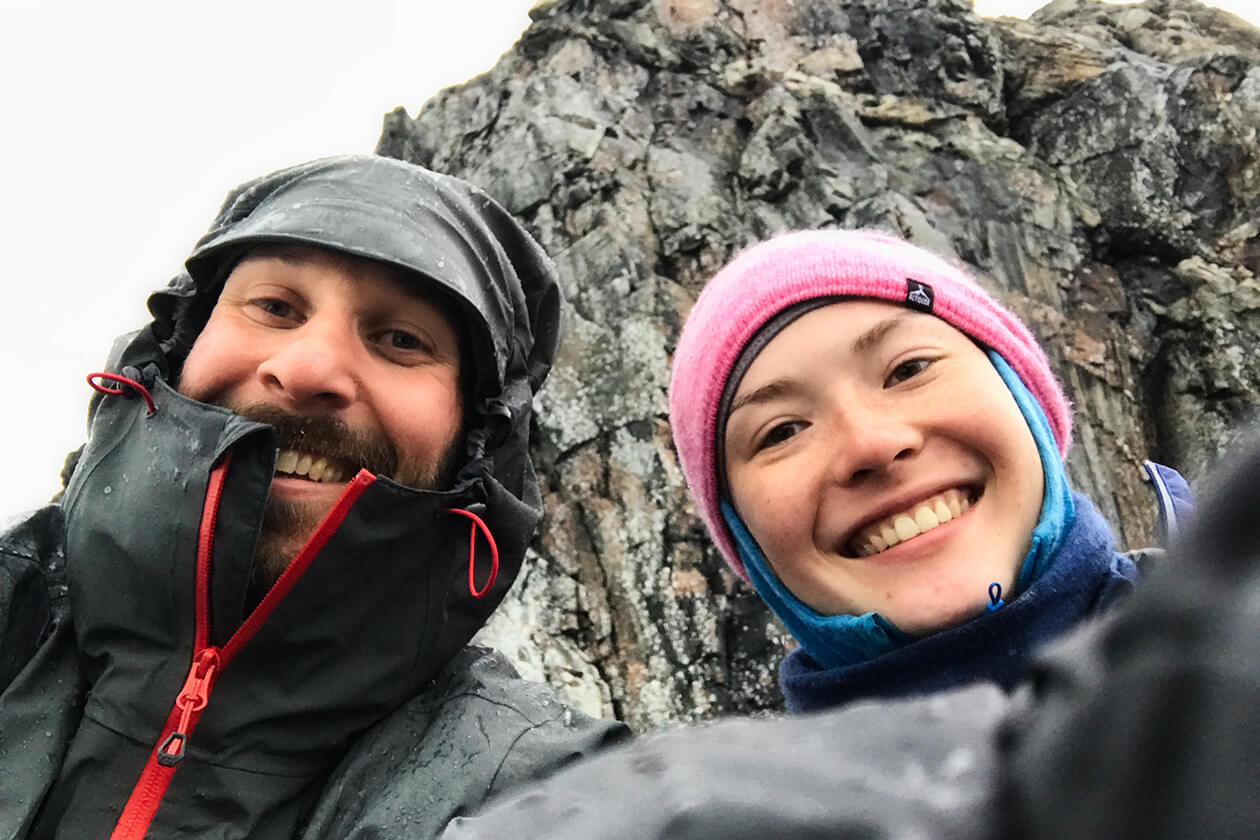
As we got back down to Hendrik, we found him huddling behind a rock with his umbrella, seeking shelter from the freezing wind. He told us that it had taken us 1 1/2 hours to go up and come back down. We were astonished as it had felt quite different to us. Since there was no way we were going to go over the ridge to the Pårte observatory that day we chose to traverse the Bårddejiegna glacier to get down into the valley below and pitch our tent to get out of the weather. We stuck to the left side of the glacier to avoid icy water which was flowing down on it and be on the right side of the rapids melting from the glacier once we reached the bottom. While walking on the ice there were parts of the ice which were partially melted so a lot of the time, we were actually wading through ice water and icy slush. When we finally reached the bottom, the landscape was like on another planet. Because the weather was so bad, we used the GoPro and our phones to document some of our descent.
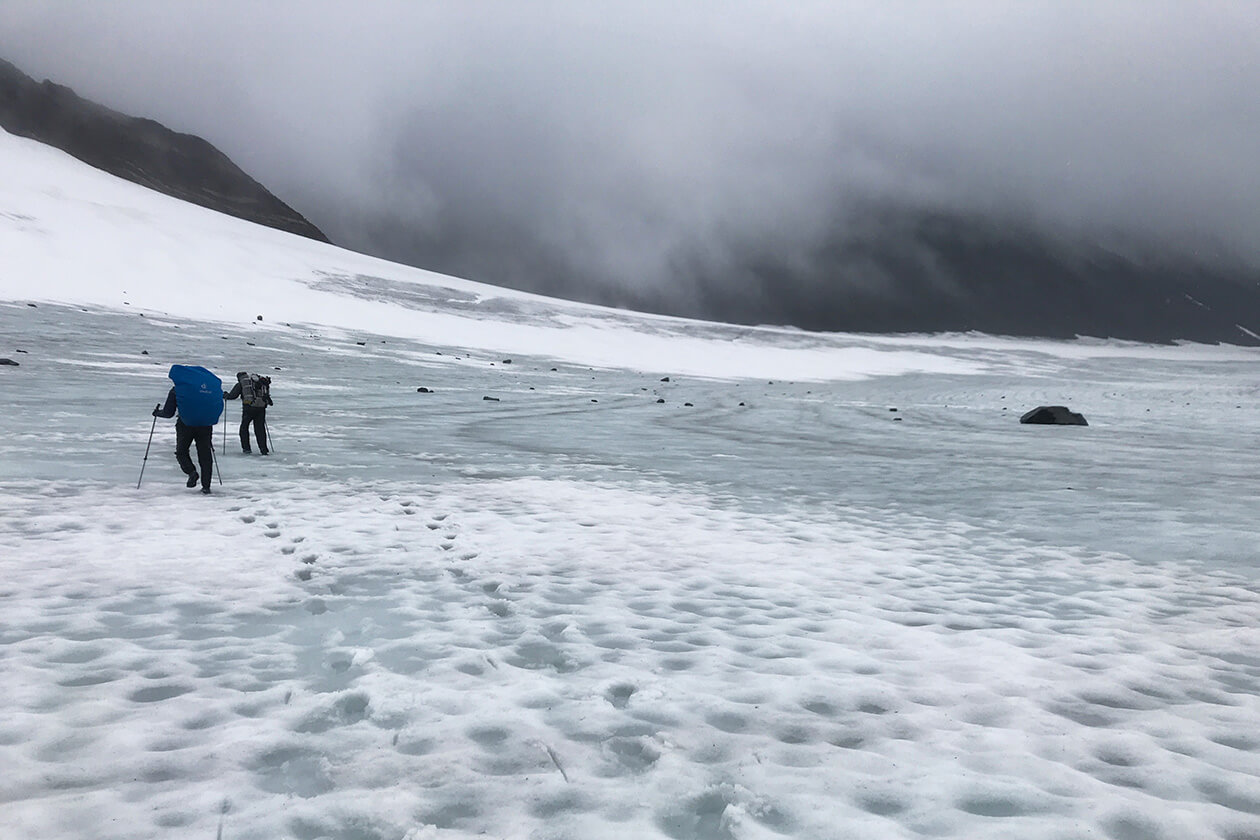
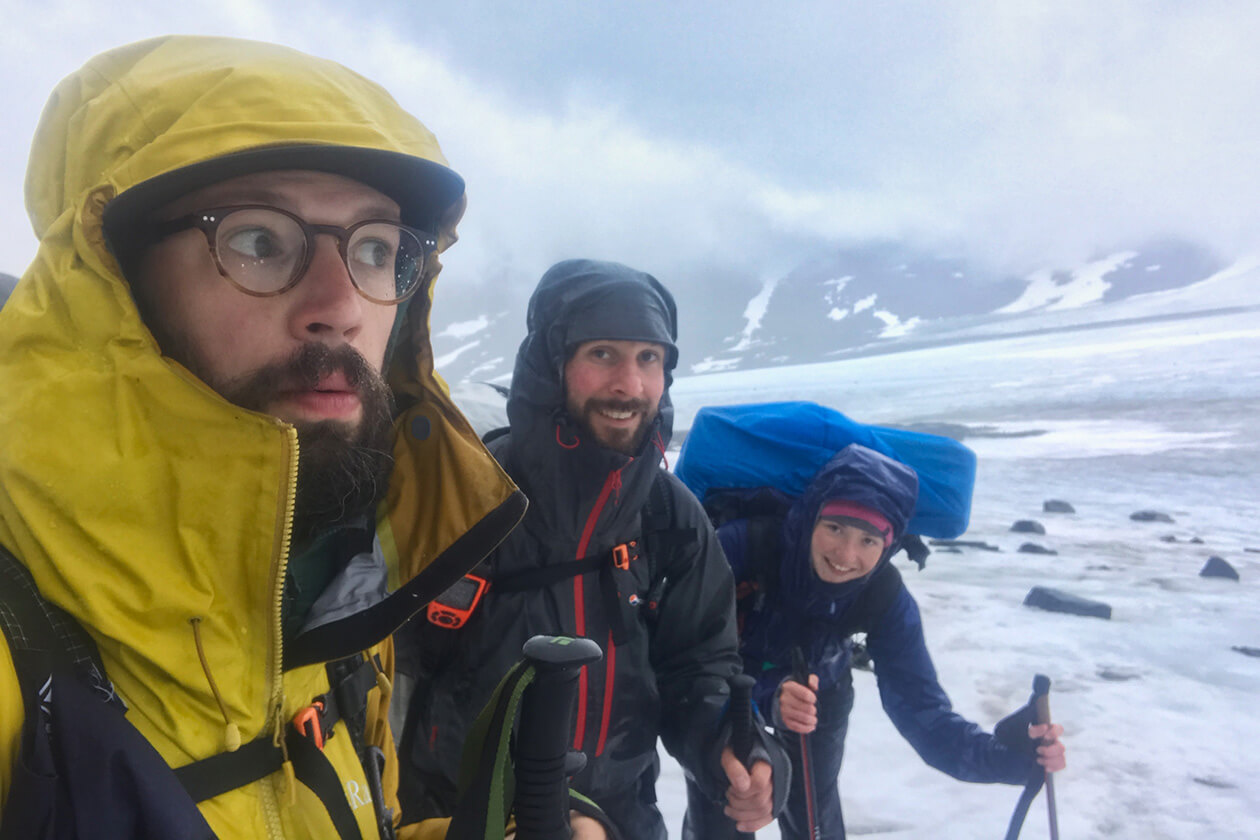
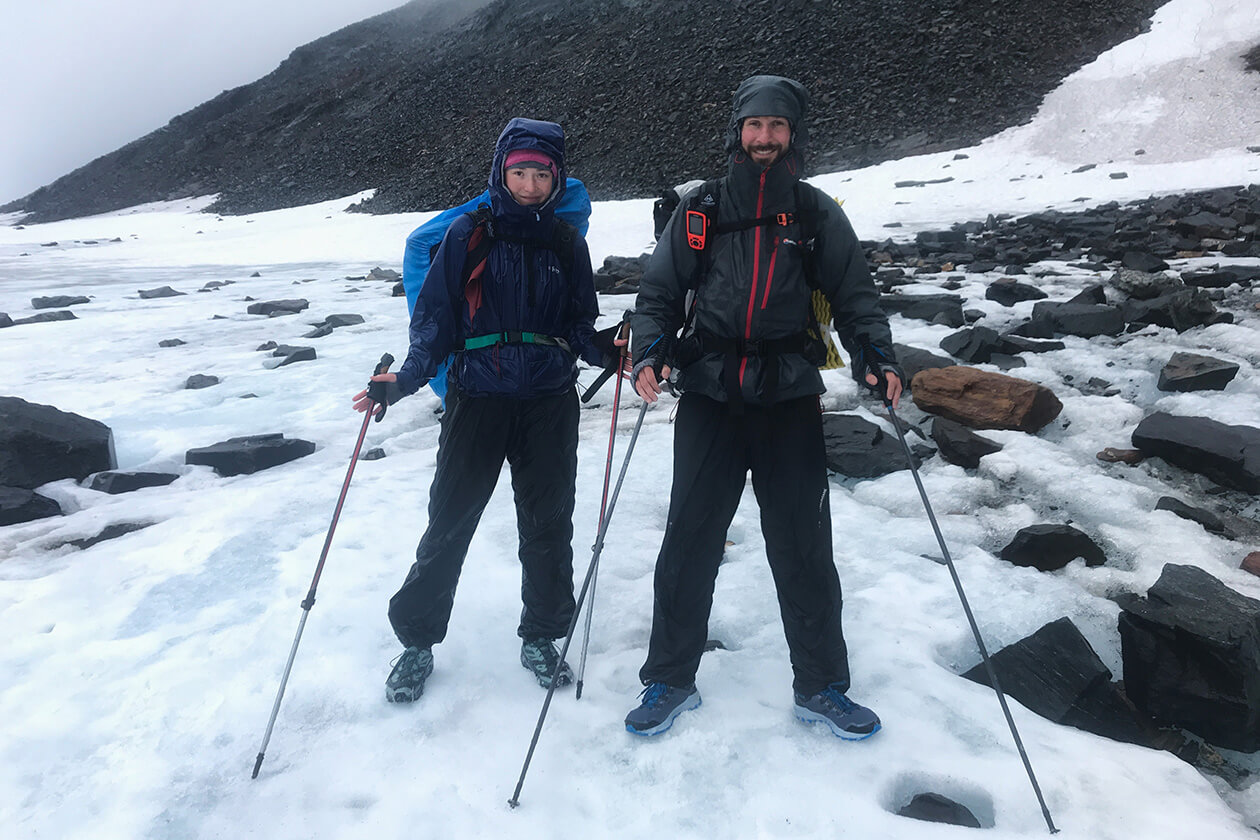
It took about another hour after leaving the glacier for the landscape to transform into something more favorable to pitch a tent. We found a really nice lake with pristine water and pitched the tent to get out of the rain. Our shells had been leaky since we had traversed the glacier about half-way down. A hot meal and our sleeping bags were the only thing that could get us warm and dry. We kept all of the layers on, which were still dry enough so that they would dry from our body heat and shed everything which would risk getting our down bags and puffy jackets wet by condensation. We immediately boiled some water to prepare our dehydrated meals and right after made some ginger tea with liquorice root and peppermint. This helped warm us up a great deal. We went to sleep immediately afterward. What a day! Good thing our core layers hadn’t gotten too wet as it was pretty cold that night for a couple hours. We could definitely feel autumn setting in that night. The nights had also become much darker than they were at the start of our hike. Unfortunately it was way to wet to take lots of photos during this part of the hike.

17.08.2019 / 18.08.2019 - Day 15/16: Backcountry marathon from the base of Bårddejiegna to Kvikkjokk:
I kind of had an idea of what we were getting ourselves into when we decided to make a run for it to escape the bad weather because I had done it a couple of times before. The weather report we had pulled off the GPS had revealed that it would only become worse over the course of the days to come and instead of constantly hiking through the rain or staying in the tent for many days to avoid it we thought we’d take the chance to get out dry while this was an option. The weather that day started out with pretty intense rain.
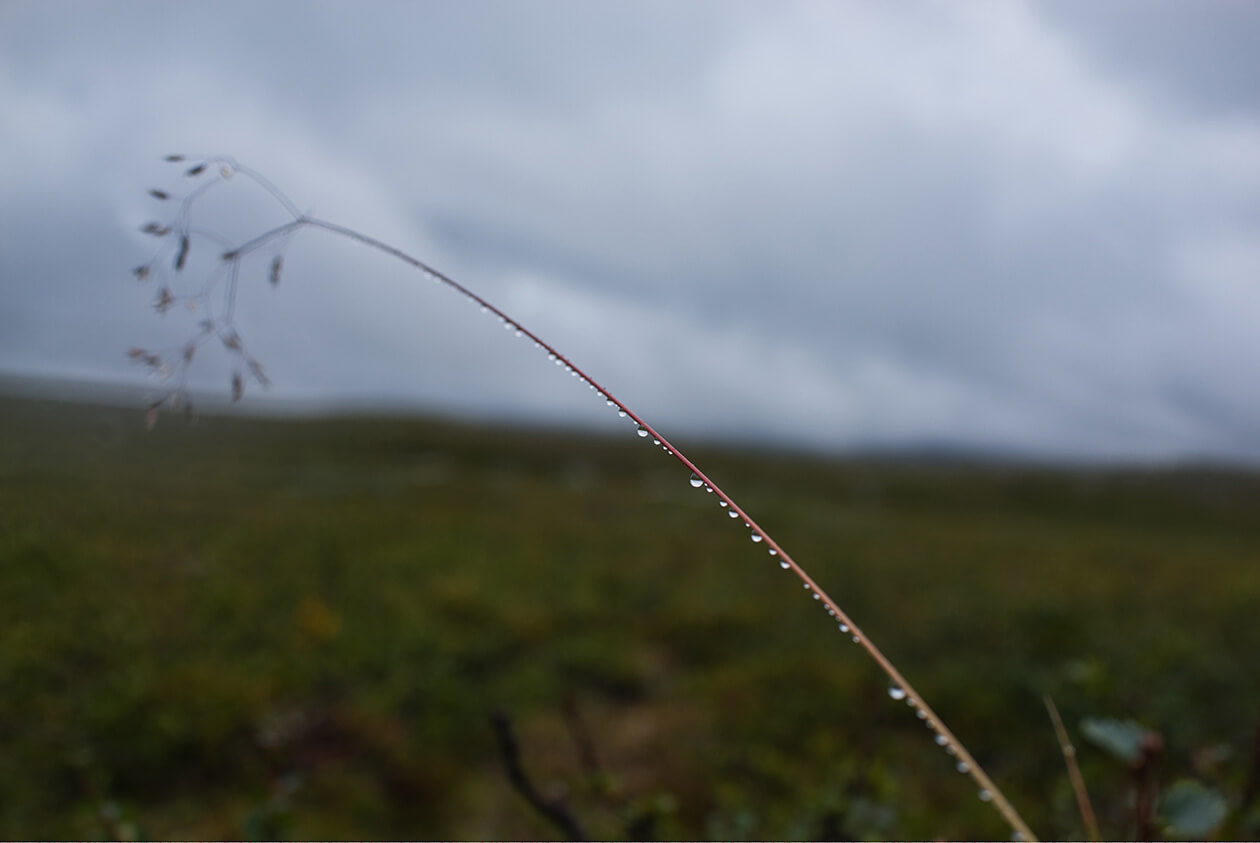
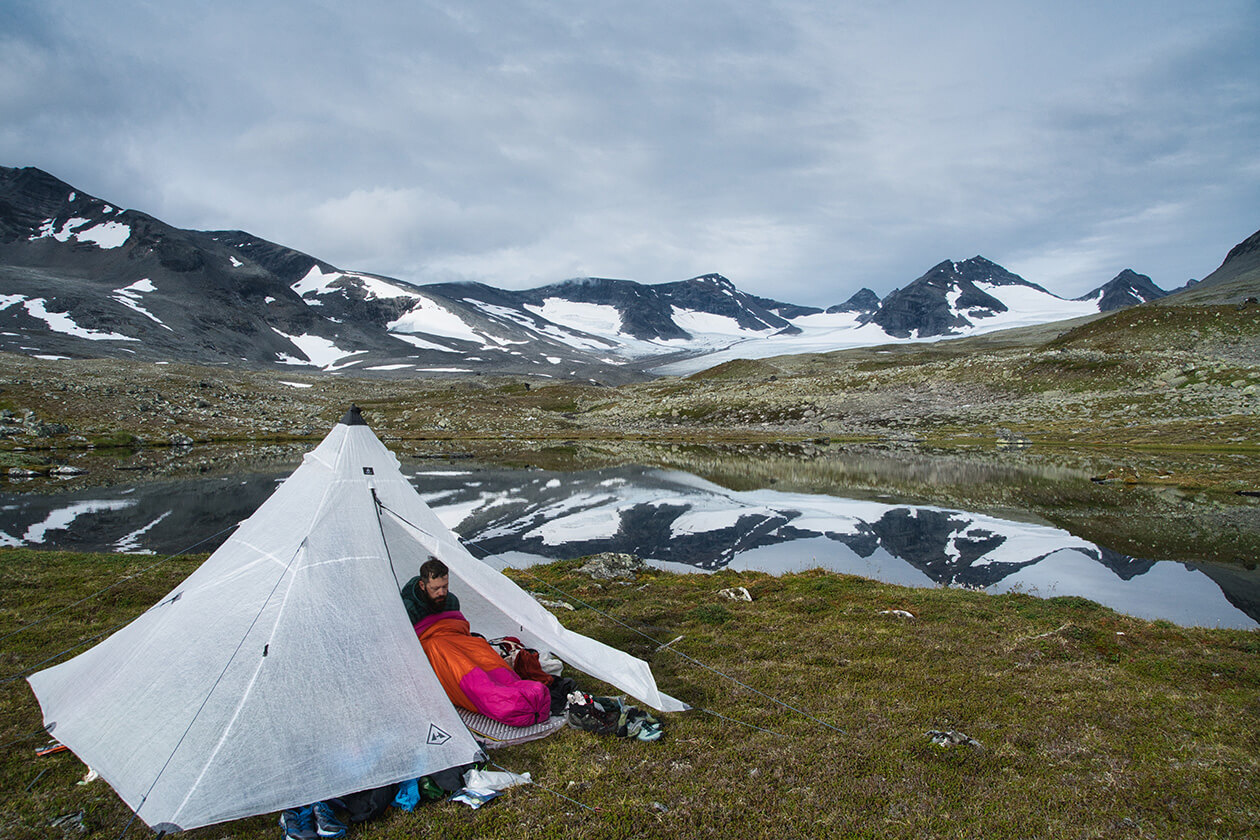
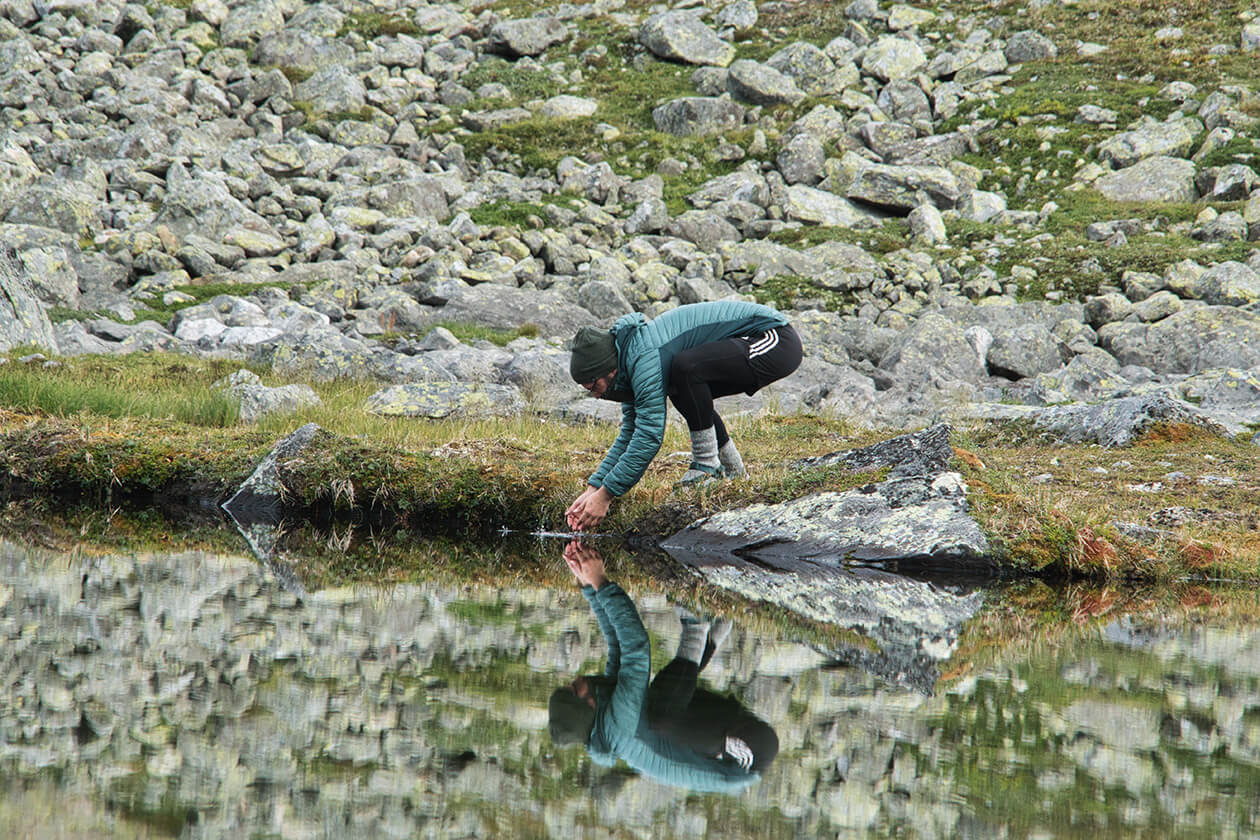

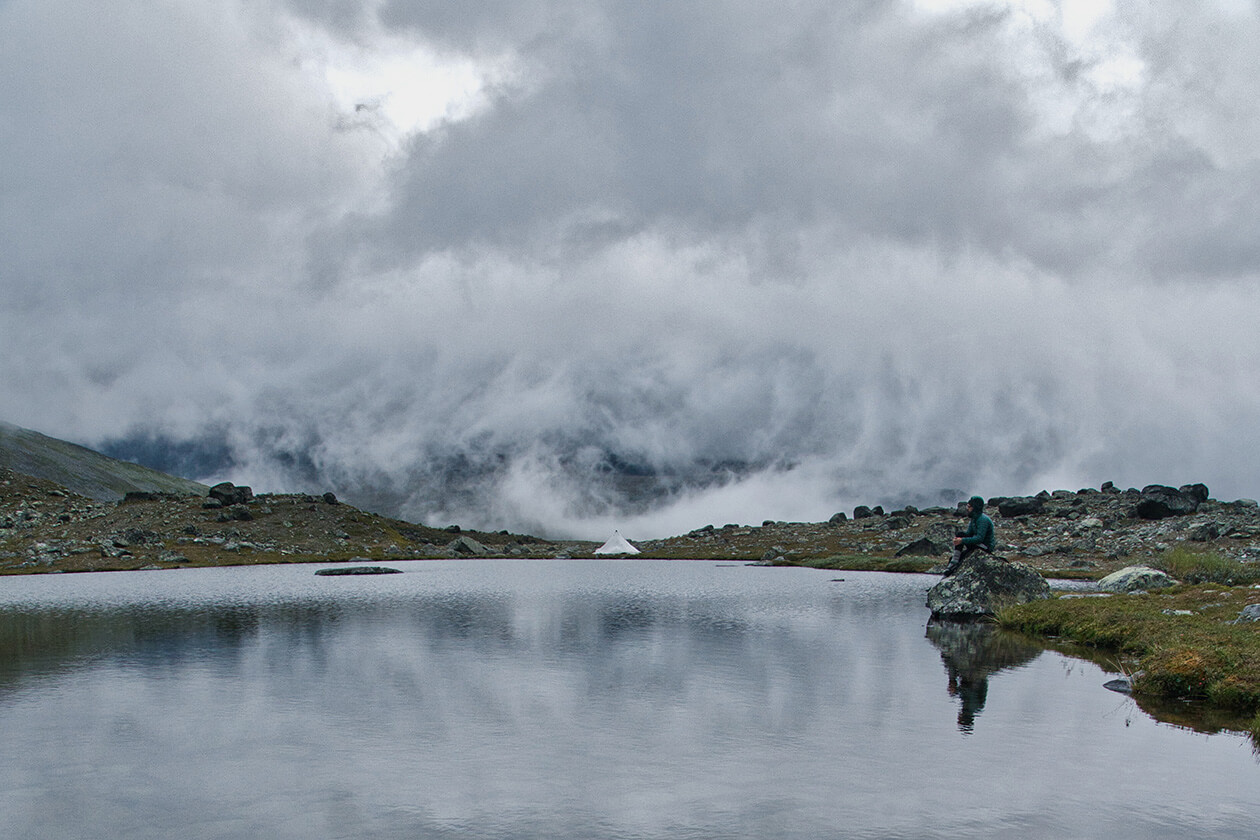

Our shells had dried overnight but once a shell layer has become compromised, it will soak through faster. Our shells had been through a lot. Especially those first couple of days we used them as a bug repellent and had constantly drenched them in our sweat had probably taken their toll on the membranes. After about two hours we felt the wet seep in. There were lots of places where we had to ford rivers that day and our shoes and socks were drenched. That day we invented a new 6-step rating scale for the wetness of shoes: It went from dry to drenched.
Dry: Your feet, shoes and socks feel completely dry
Moist: The feeling of sweaty feet or socks but it will dry in no time
Damp: A dampness which can be felt through your shoes and socks and which takes at least an hour of walking in dry weather to subside.
Wet: Your shoes are completely saturated and feel cold and wet but no ‘squishy’ sounds can be heard.
Saturated: Your shoe feels thoroughly saturated and every step emits a ‘squish’
Drenched: Water squirts out from the mesh areas of your shoe with every step – A drenched shoe can become merely saturated within about 10 minutes of walking
For about the first four hours of that day our shoes went from being between wet to drenched and back again. In between we experienced phases of mere dampness but never got to the simply moist stage, as there would be either rain or some swampy area which would bump them back up to being either drenched or at least saturated. After some time of walking in wet shoes you learn to appreciate a shoe that is merely wet. So even with completely wet shoes you don’t want them to become drenched again. So for every ford we had to do, we still took off our shoes, wrung out our wet socks, put them back on and hiked on.

Wringing out your socks and getting back into them when they are only wet has a very positive effect. Wringing them out time and time again is something worth doing as it will extend the lifespan of your foot on a long hike. We hiked until we had almost reached the bridge.
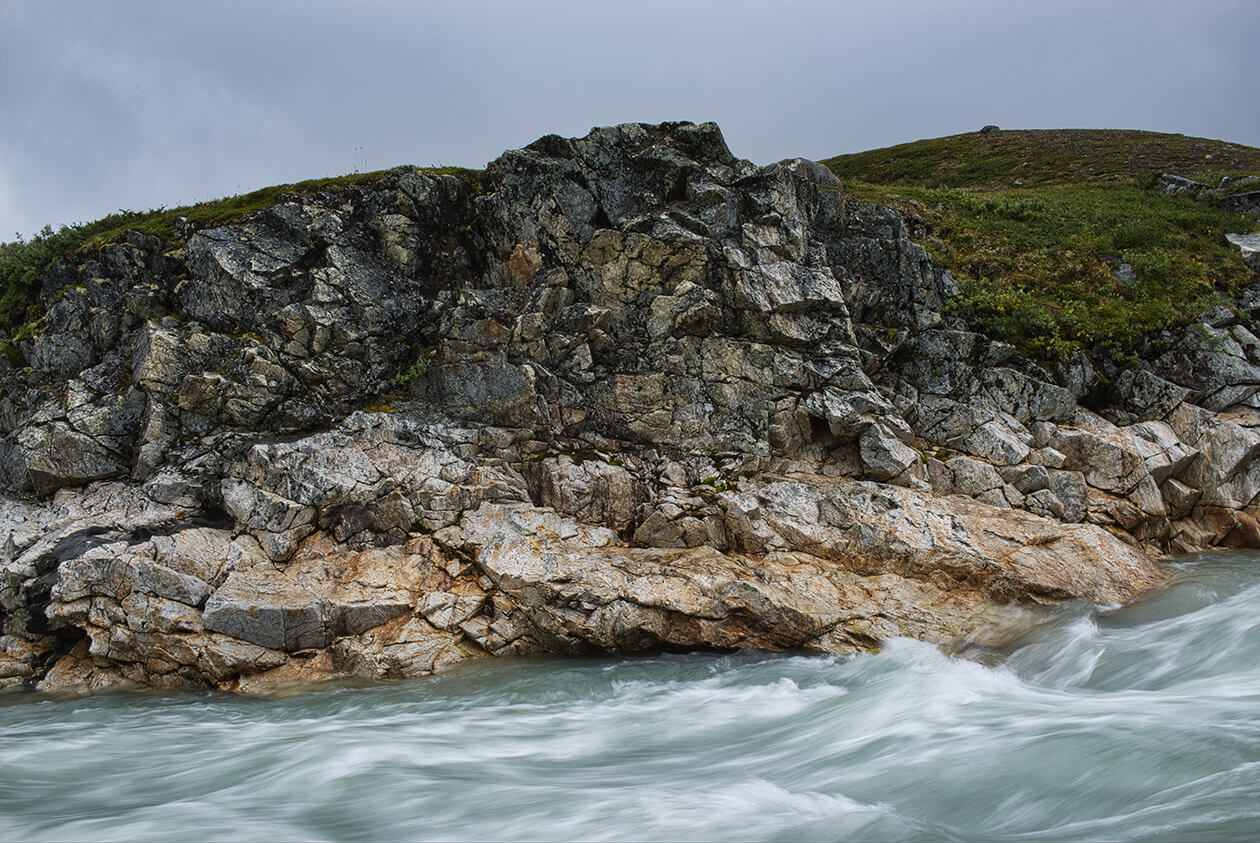
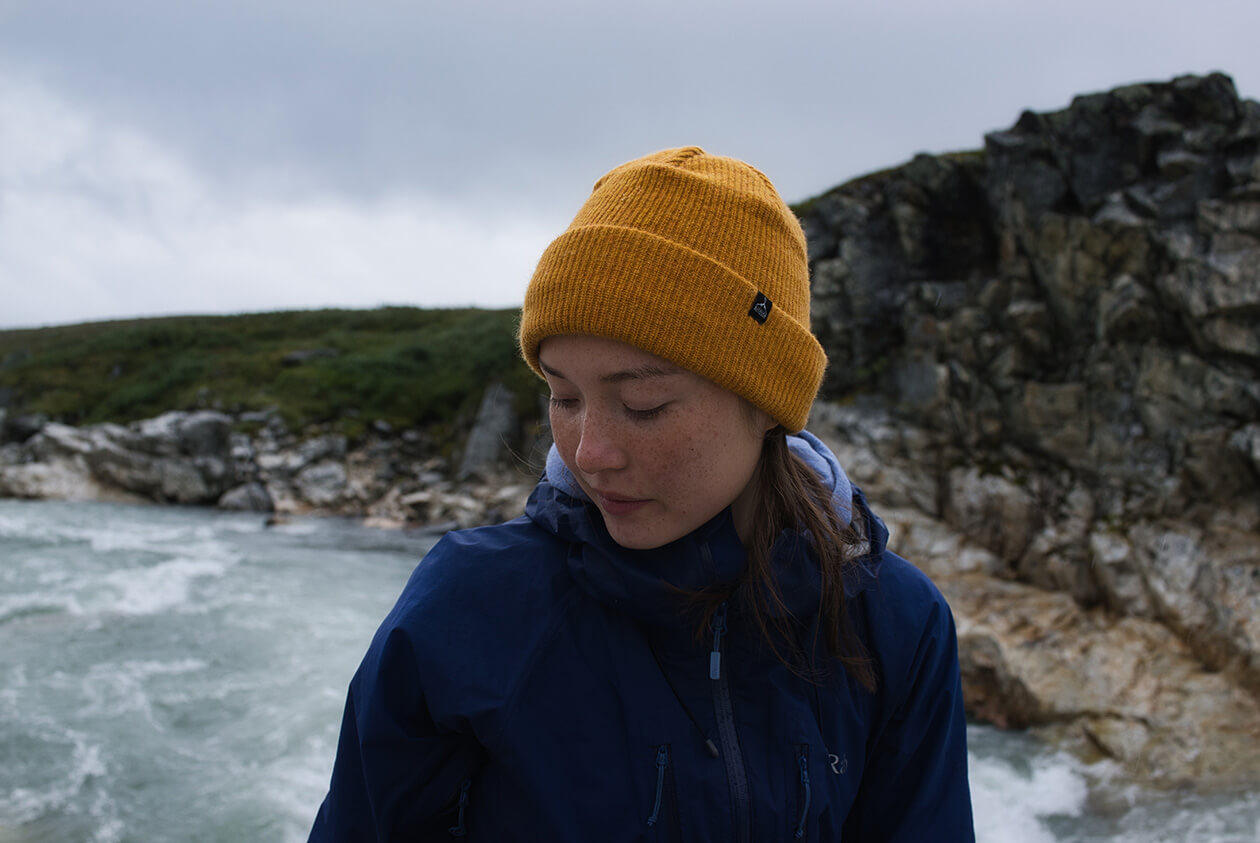
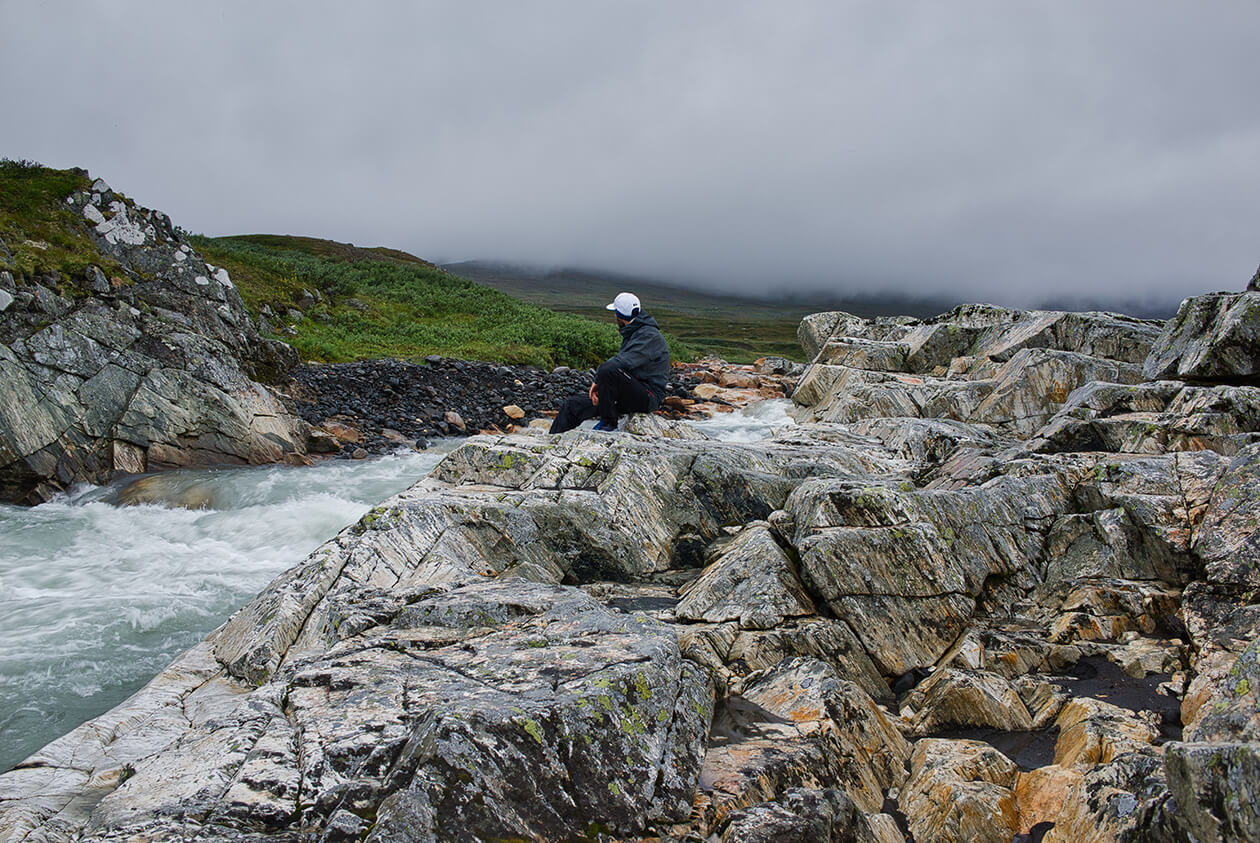

The rain stopped and took a lengthy break and we took some pictures at a beautiful rock formation close to the rushing river. This is a really beautiful area, which I will visit again someday, with hopefully better weather conditions. After crossing the bridge, we found a trail and quickly lost it again. It stopped near a sacrificial space, where the Sami had laid out reindeer antlers in a circle with a skull at the center, as they often do. Such areas should not be disturbed in any way.

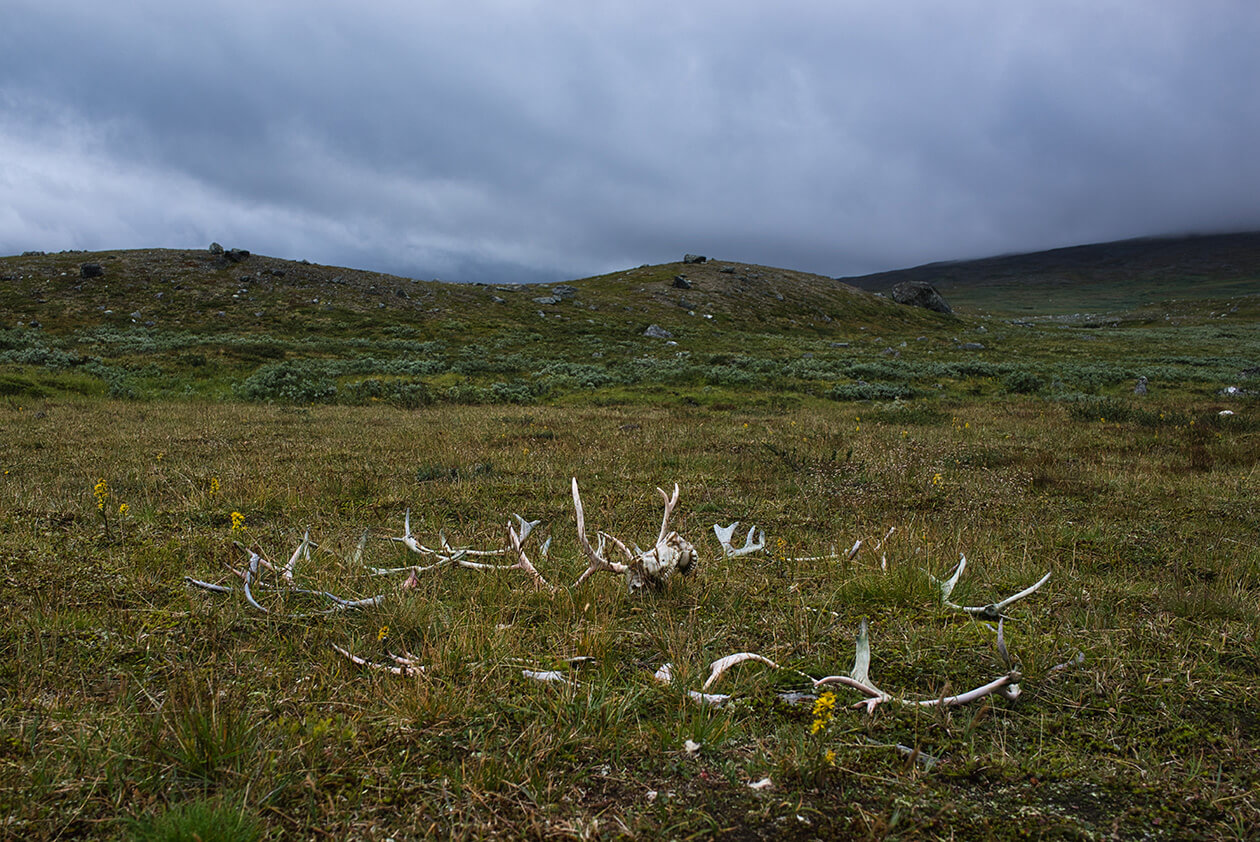
Traditional Sami spiritual practices and beliefs are based on a type of animism, polytheism and what anthropologists consider shamanism. The religious traditions can vary considerably from region to region within Sápmi. Traditional Sami religion is generally considered to be animistic. The Sami believe that all significant natural objects (such as animals, plants, rocks, etc.) possess a soul, and from a polytheistic perspective, traditional Sami beliefs include a multitude of spirits. Sámi traditional beliefs and practices commonly emphasize veneration of the dead and of animal spirits. The relationship with the local animals that sustain the people, such as the reindeer, are very important to the kin-group.
Behind the bones, a very swampy region began. We had to keep our shoes on because of all the low brush, which would have surely hurt our feet if walking in sandals. So with drenched shoes we squished our way through the swamp. After a longer stretch of bushwhacking we reached dry ground after crossing another small ford. After another short break and wringing out our socks we continued onward toward Boarek.
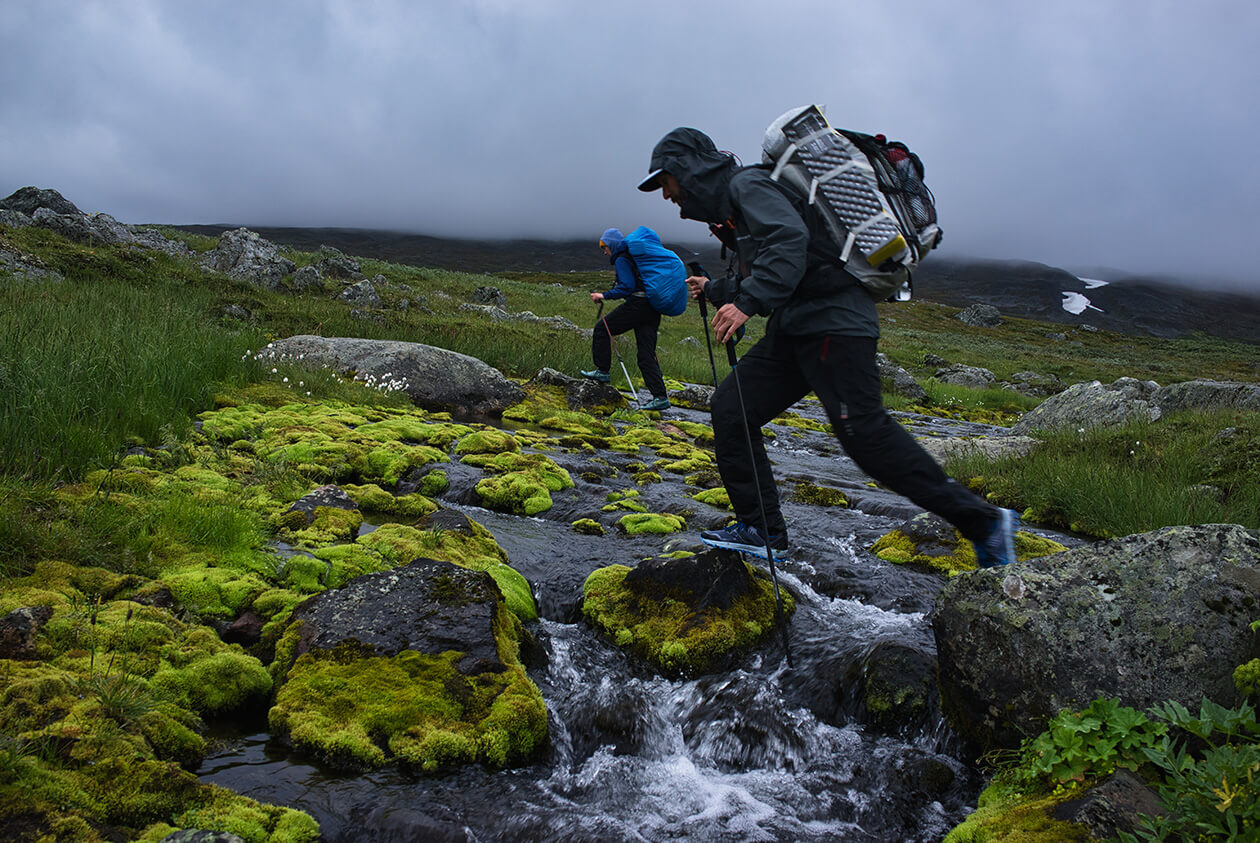
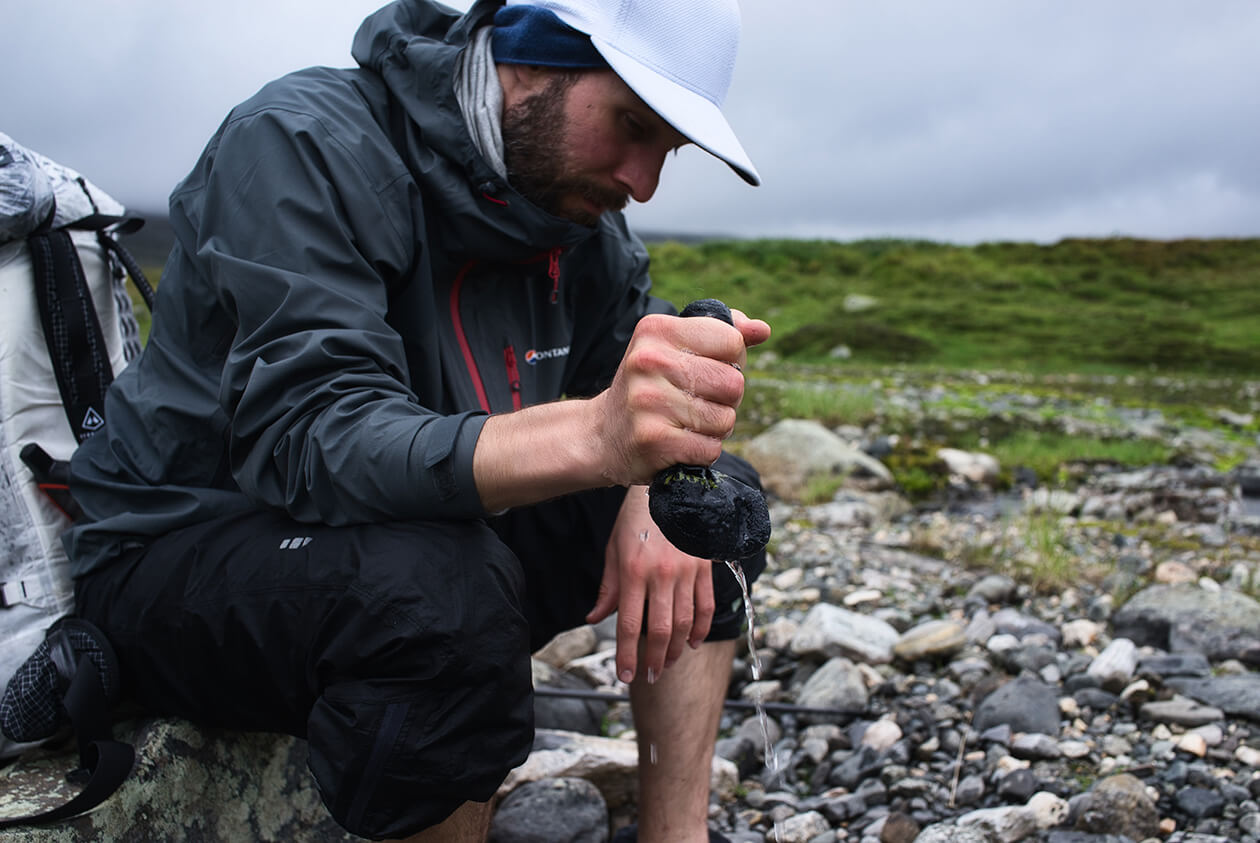
Our way led us between Boarektjåhkkå and Stuor Jierttá. It was a long hike. The weather had stabilized over the course of the afternoon. Some sections were dense in fog and there was the odd short drizzle here and there but altogether we were lucky. At some point we reached a long fence, which we had to unhinge to get through as there was no other way of passing it. From afar we had mistaken this area to be Boarek but it quickly became clear that the buildings were only storage sheds where the Sami kept their fences and other maintenance gear. We continued until we found a trail marked with blue color on some rocks next to it. We could already see some houses amongst the trees down below.
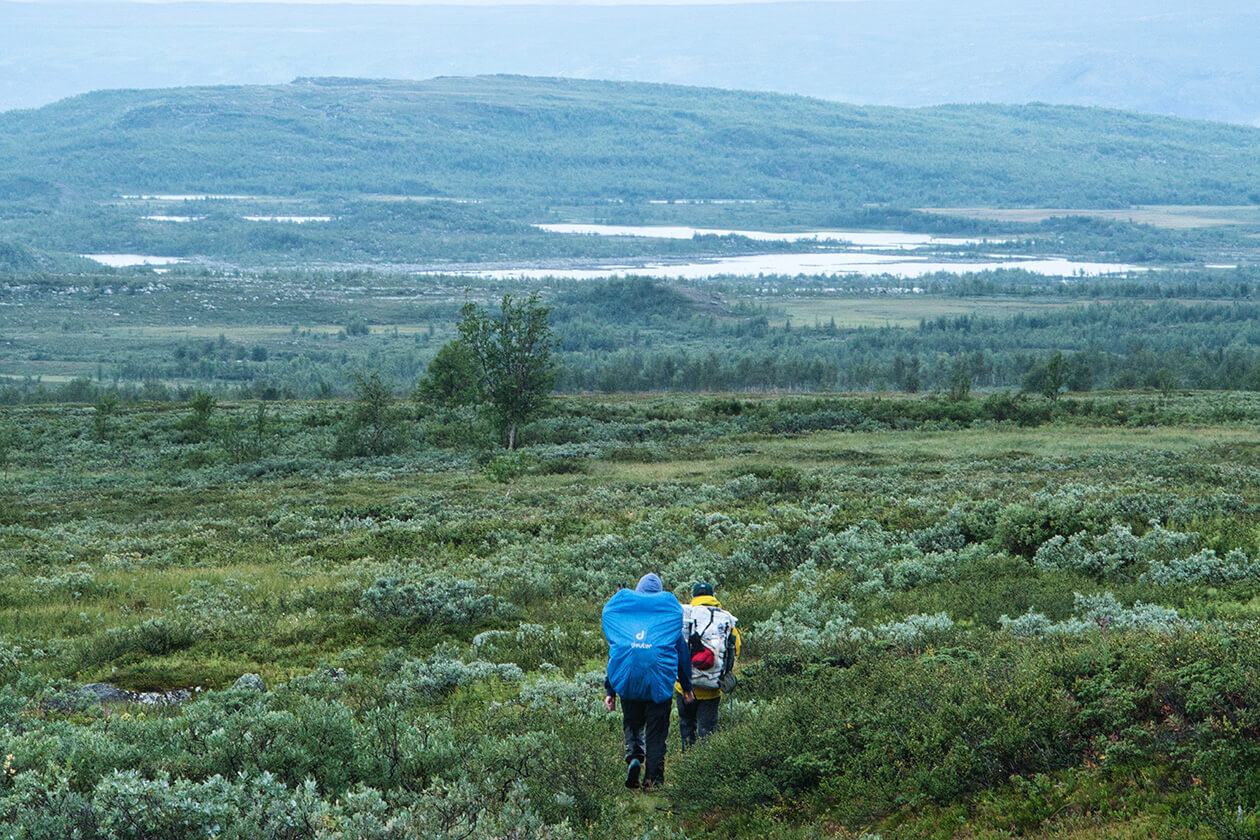
The place was deserted. We took a short break to cook some dinner as we would need the calories that night. As soon as we stopped, we were instantly attacked by swarms of mosquitos. It was feeding time for us and them. We quickly gobbled down our food and continued onward on the ‘trail’ – The trail seemed to lead nowhere and became more overgrown by the minute. At some point it got pretty dark and we had to light up the headlamps to see. Since there was no trail anymore and we were in the middle of thick brush and trees, we navigated toward where the main trail was supposed to be on the GPS device. After about 30 minutes of hard bushwhacking we actually found the trail and were relieved that we had found it that fast. We quickly got to where the trail splits and there is a small path leading to the Axel Hamberg house. Axel Hamberg was a Swedish mineralogist, geographer and explorer well known for exploring and reasearching the Sarek National Park.
There were a bunch of signs pointing in different directions where the trail split. There was a sign pointing to Kvikkjokk – 19 kilometers! We had already walked for a long time. This would be a test for body, mind and soul. We thought we’d give it a try. I myself had done long speedhikes like this before and I knew what was to come: It would hurt a lot! It quickly became very dark and we could only see the trail with our headlamps. Since we were used to walking offtrail for the past two weeks, we felt supercharged. We walked very fast. At times there were stretches of trail where wooden planks had been laid out. These were bliss and we could almost run because our packs had gotten quite light as we had eaten most of the food. Our feet were still pretty wet and we knew that the point would come when this would start hurting.
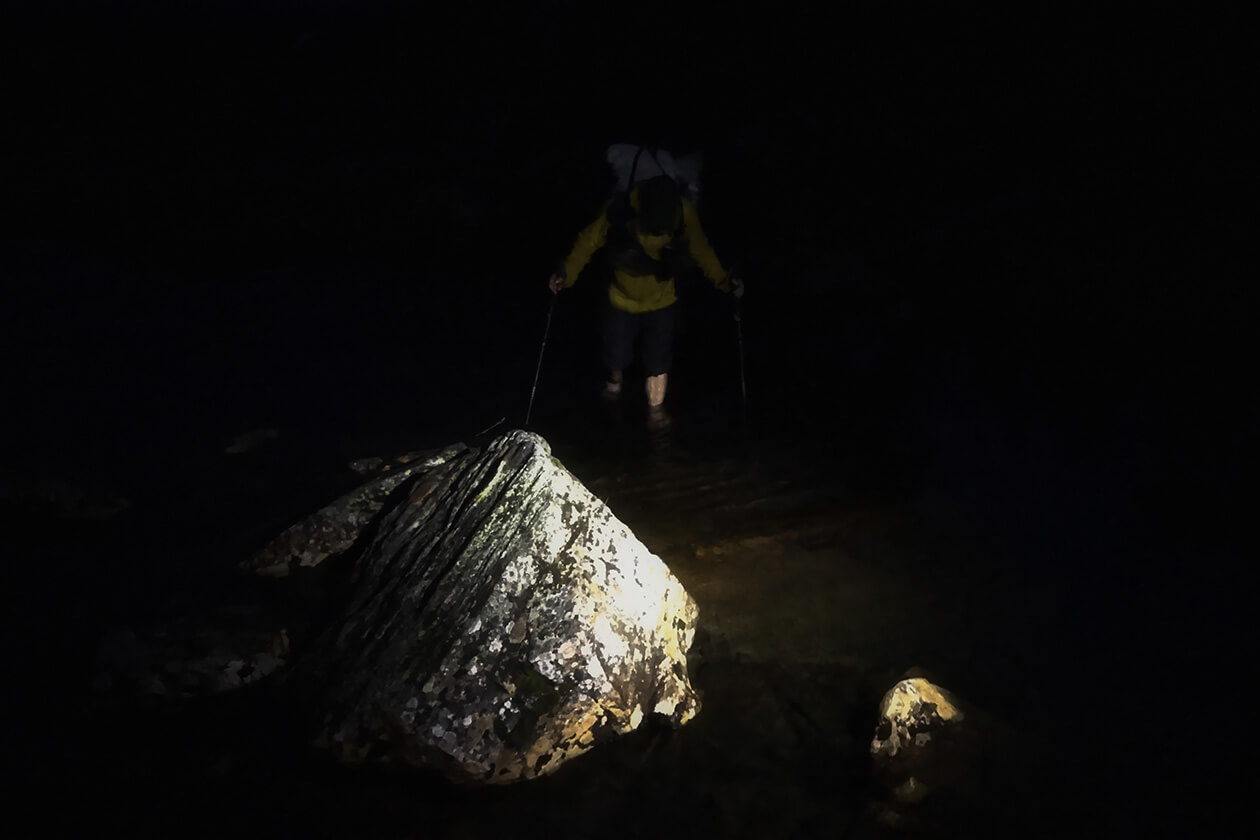
We desperately needed to dry our shoes and socks so we started collecting firewood next to the trail while hiking onward. At some point we started to smell fire. At first, I thought this was my imagination but after a while I stopped to ask the others and they had also smelled it. At some point we heard voices and there were people camped at the side of the trail. They told us that they still had embers and we were more than welcome to use their embers to get a fire started. This saved us so much time! The wood we had gathered quickly burst into flames and we sat there for about 1 ½ hours drying our feet, shoes and socks. Sitting by the fire had an energizing effect on us and as we started to hike afterwards, our pace quickened quite a lot.
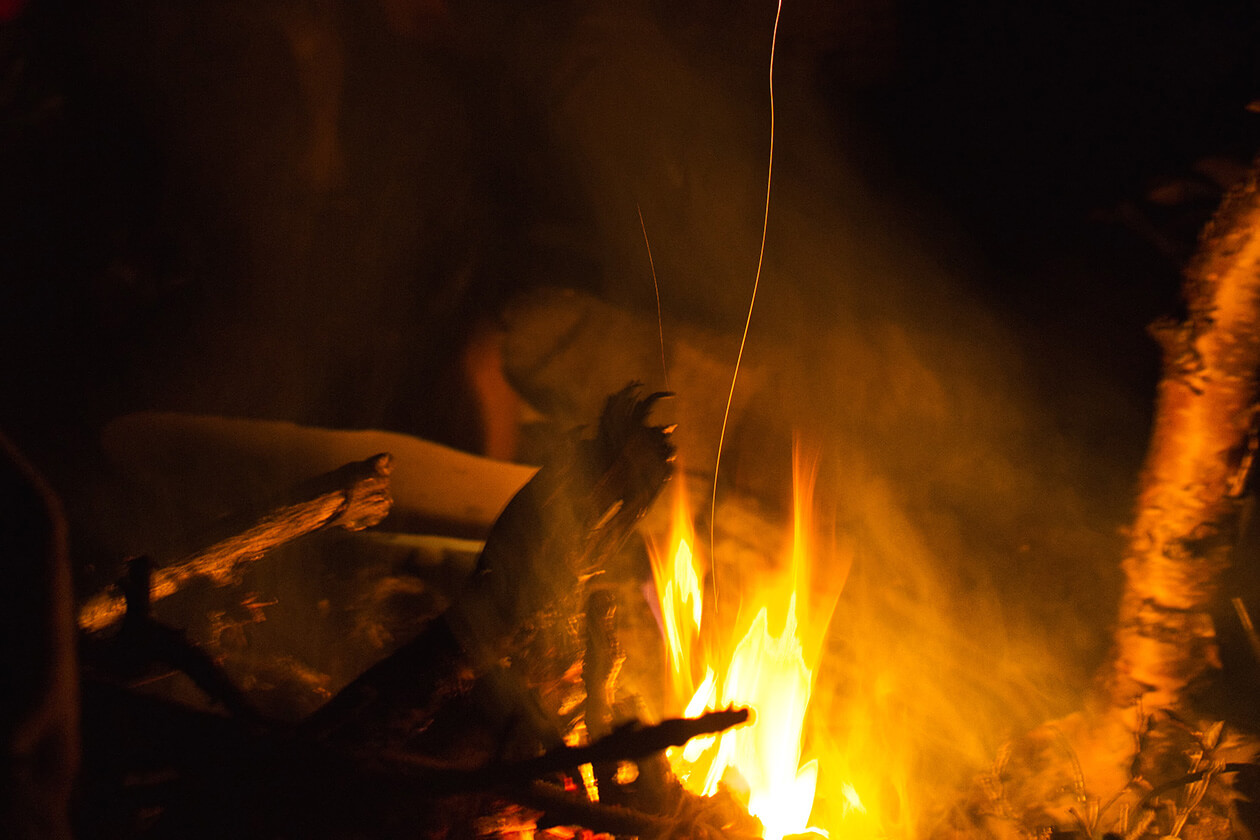
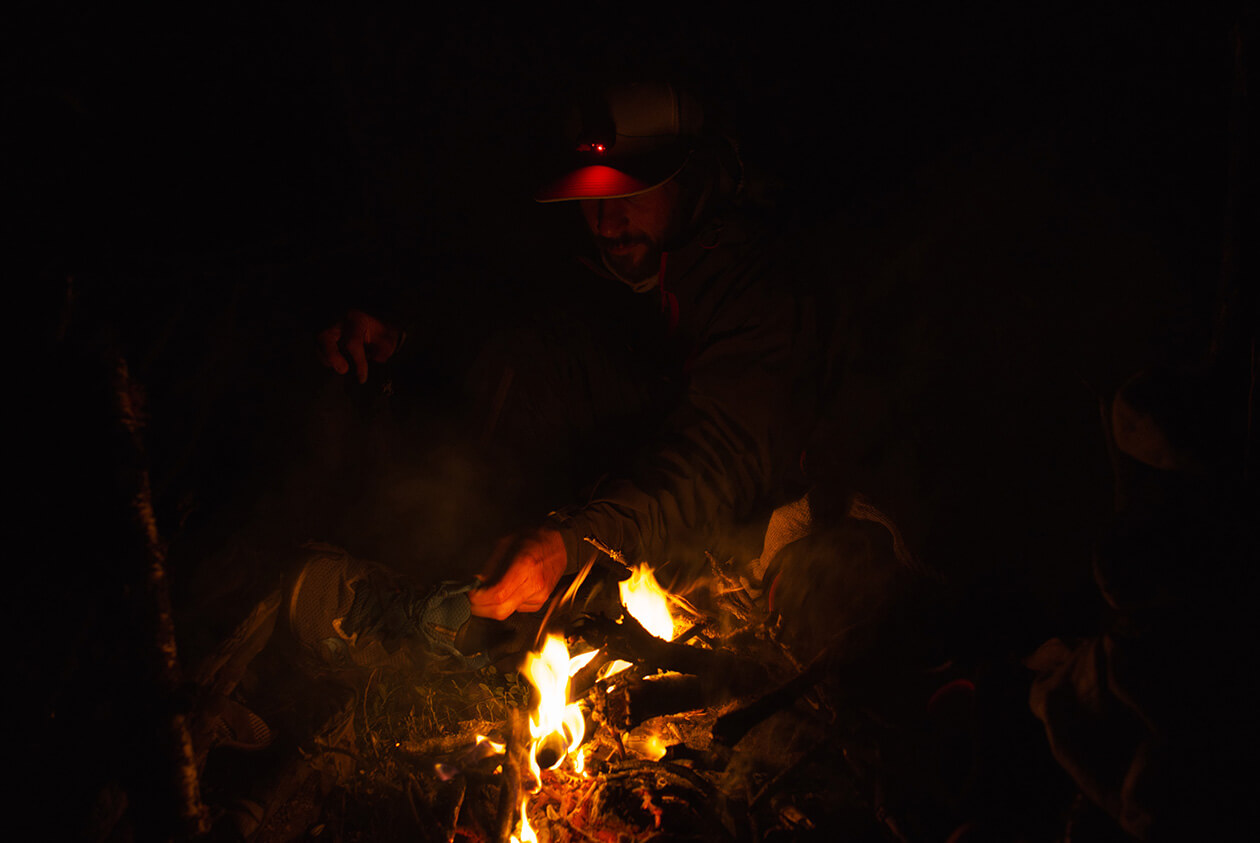
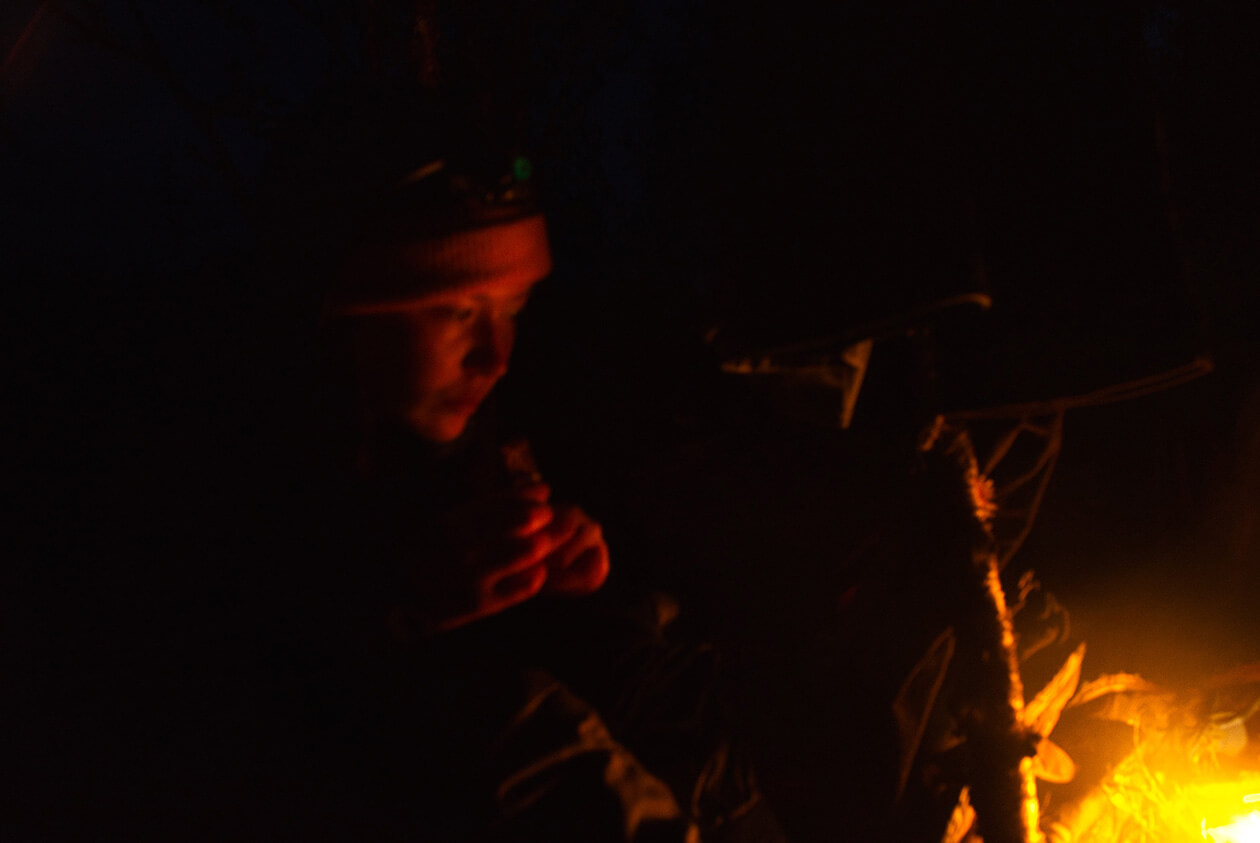
The luxurious feeling of dry warm socks and shoes was otherworldly. Time flew on our way to the next intersection. It started to get light again. Shortly after we got to the next intersection where the path to Boarek meets Kungsleden there was a sign: 6km to Kvikkjokk. We felt pretty drained at that point. Not only were our bodies telling us to stop, our minds were becoming fuzzy from being awake for so long. The next part of the section down to Kvikkjokk was going to be an ordeal. There was almost no talking anymore on this stretch. All we could hear was the clicking of our hiking poles and our own panting. After another one and a half hours or so we reached Kvikkjokk at 6:30. The shop was still closed.
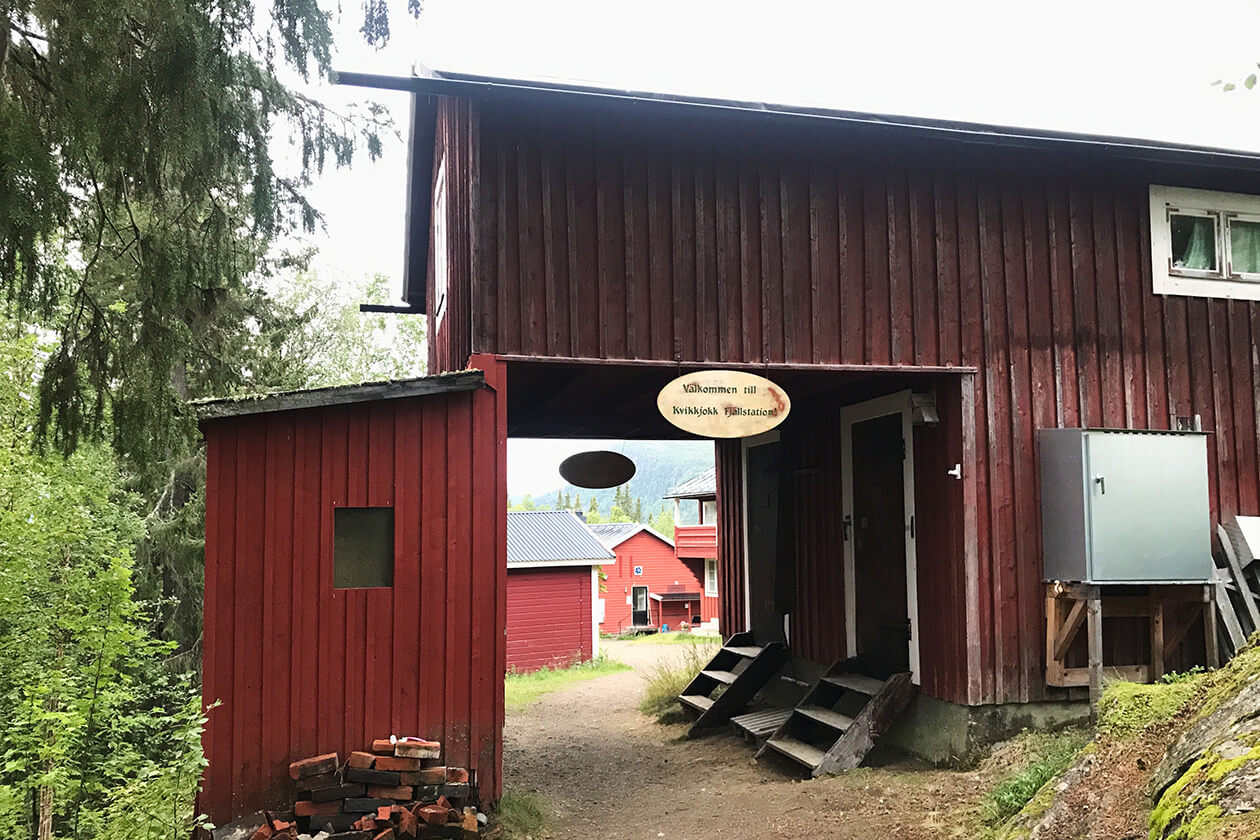
We had already fantasized about eating French fries for breakfast but this was not to be as they don’t sell any in the morning. We settled for a nutritious breakfast of coffee with potato chips and an apple. When we got to Kvikkjokk we instantly popped out of our shoes and into our sandals. What a relief! The bus that would take us back to Gällivare that day where our train would leave a couple days later left at 9:00 in the morning. Time went by fast and we quickly fell asleep on the bus. We had a 5 hour stay in Jokkmokk. We instantly raided the supermarket and devoured wraps full of veggies and lots of coffee and then hung out at the gas station for quite some time before the Bus to Gällivare came. In the evening we arrived in Gällivare and directly went for some pizza before heading to the campground.

The campground in Gällivare is quite nice. It costs 200SEK (about 20€) per night to pitch a tent, no matter how big your group is. It’s got a sauna and the facilities are very clean and tidy. We pitched our tent and went to bed quite early.
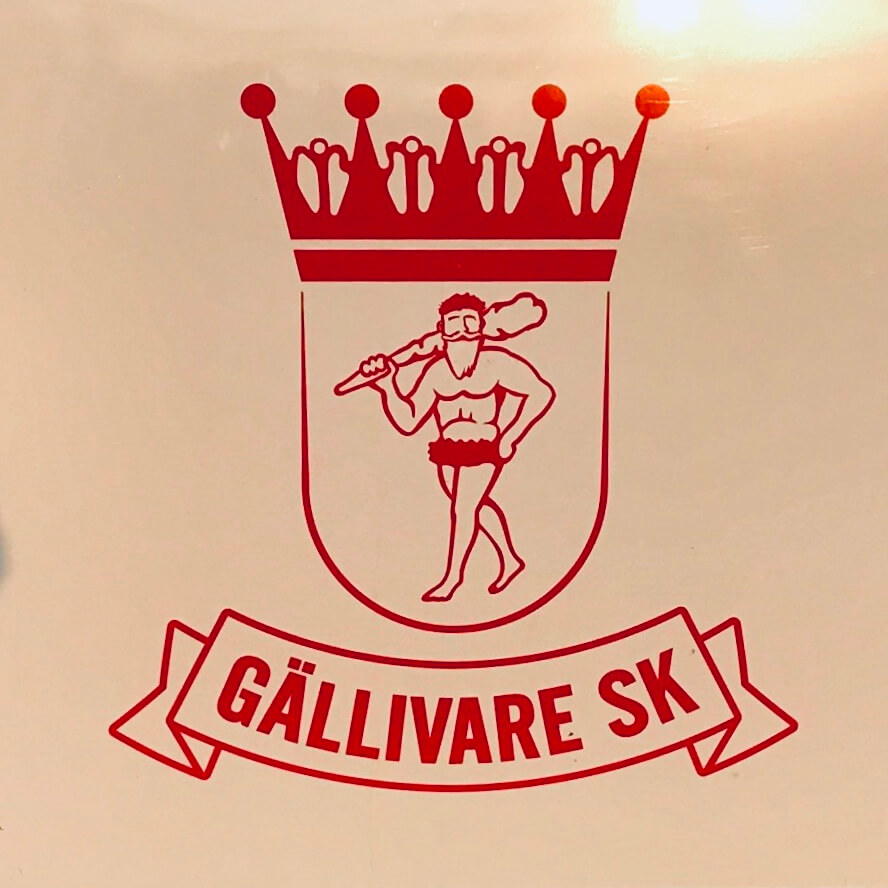
19.08.2019 – 22.08.2019 – Gällivare – The big after-tour chillout
The days until our departure can be easily summed up. In Gällivare we had quite good weather so we spent most of our time strolling around, hanging out in the sun, eating and visiting the supermarket to find out what we could eat next. Another side-project of ours was washing and drying our clothes.

Since we had another four days of time to kill until our train left, we found out that the perfect time to use the sauna is around 23:00 at night. Around that time, you’ll have the sauna for yourself because most people will be in their tents or mobile homes.
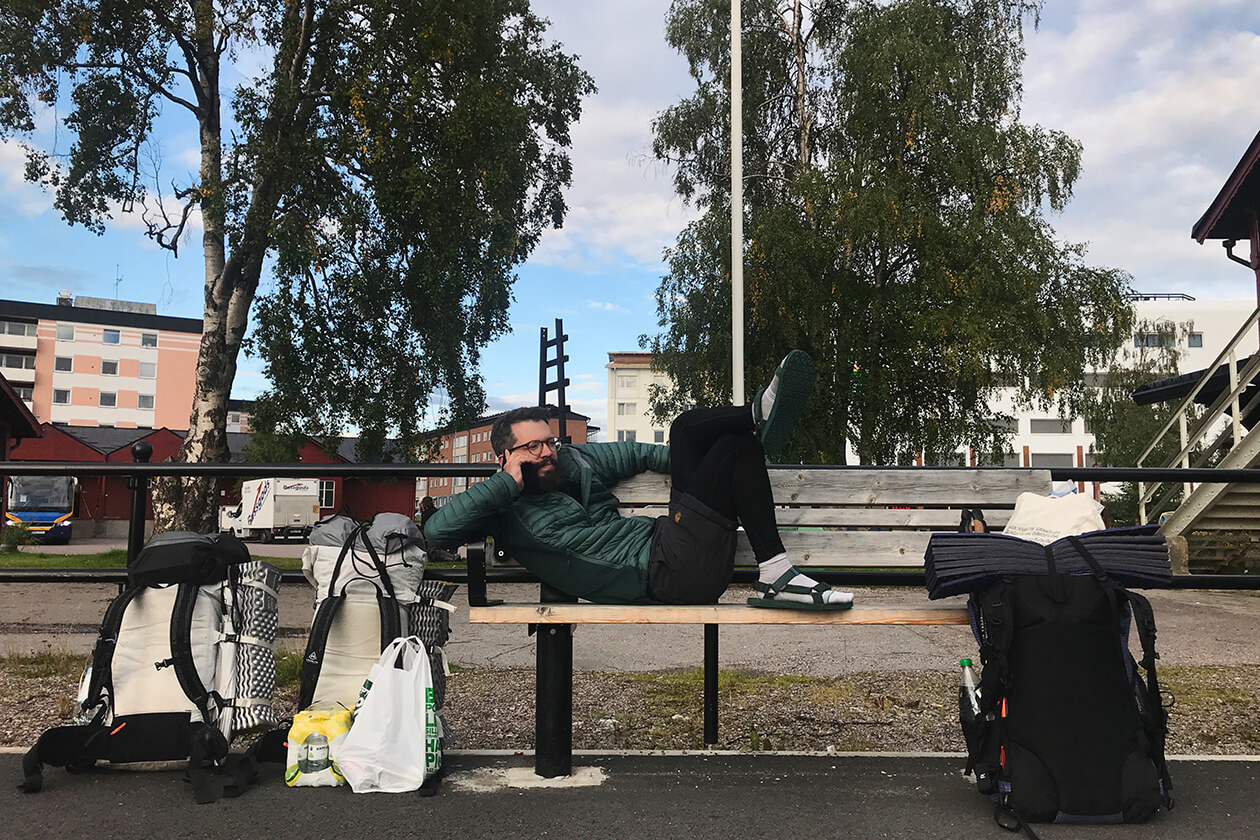
On the 22nd we took the polar express train down to Stockholm. We had a cozy private sleeping compartment for three people and had a great night. It’s often quite loud on this train because people might be drinking and partying late into the night. If you’re a light sleeper it might be a good idea to get a private compartment for your group, which costs only about 10€ more than a normal sleeping compartment. The private compartments are in their own wagon and you will also have access to a shower. It’s important to try and book your compartment as soon as possible, because this train is usually booked out pretty fast, especially if you would like a bed. Since it’s an 18-hour ride, having somewhere to lie down is a must.
23.08.2019 - Stockholm
We arrived in Stockholm at 9:00 in the morning. It was a very rainy day and we had a full day before our flight would leave, so we decided to leave our luggage in a locker at the train station and check out some nice places to have coffee. The day went by fast and since it was raining pretty hard, we stayed inside coffee houses and restaurants for most of the time. We had explored Stockholm more than once before, so we didn’t feel much of an urge to go sightseeing. There are many things to see in Stockholm if you have never been there. It’s a great city which is lots of fun to explore with good weather but writing about all the options would be an entire chapter of its own. If you want to visit Stockholm it is advised to book your accommodations way in advance. It’s quite an expensive city and hotel prices can go through the roof – especially if you haven’t booked anything in advance. We would advise you to take at least three to four days to fully explore Stockholm, maybe even a day or two more if you want to also visit Uppsala, which is close by and worth visiting. If you like coffee, cake and beautiful countryside, Sweden should definitely be on your bucket list.






















